
Revision 1.05
Order Number: 332060-004
Real Time Instruction Trace
Programming Reference
December 2015

Contents-Real Time Instruction Trace
Revision 1.05
Order Number: 332060-004
Intel technologies features and benefits depend on system configuration and may require enabled hardware, software, or service
activation. Learn more at intel.com, or from the OEM or retailer.
No computer system can be absolutely secure. Intel does not assume any liability for lost or stolen data or systems or any damages
resulting from such losses.
You may not use or facilitate the use of this document in connection with any infringement or other legal analysis concerning Intel
products described herein. You agree to grant Intel a non-exclusive, royalty-free license to any patent claim thereafter drafted
which includes subject matter disclosed herein.
No license (express or implied, by estoppel or otherwise) to any intellectual property rights is granted by this document.
The products described may contain design defects or errors known as errata which may cause the product to deviate from
published specifications. Current characterized errata are available on request.
This document contains information on products, services and/or processes in development. All information provided here is subject
to change without notice. Contact your Intel representative to obtain the latest Intel product specifications and roadmaps.
Intel disclaims all express and implied warranties, including without limitation, the implied warranties of merchantability, fitness for
a particular purpose, and non-infringement, as well as any warranty arising from course of performance, course of dealing, or
usage in trade.
Copies of documents which have an order number and are referenced in this document, or other Intel literature, may be obtained
by calling 1-800-548-4725, or by visiting http://www.intel.com/design/literature.htm.
Intel Atom, Intel Core, Intel and the Intel logo are trademarks of Intel Corporation in the U.S. and/or other countries.
*Other names and brands may be claimed as the property of others.
Copyright © 2015, Intel Corporation. All Rights Reserved.

Real Time Instruction Trace-Contents
Real Time Instruction Trace
Programming Reference v1.05
December 2015
4
Table of Contents
LIST OF FIGURES......................................................................................................................................7
LIST OF TABLES........................................................................................................................................8
REVISION HISTORY................................................................................................................................9
1 INTRODUCTION.................................................................................................................................11
1.1 OVERVIEW....................................................................................................................................................11
1.2 AVAILABILITY AND USE...............................................................................................................................12
1.3 FEATURES AND CAPABILITIES.....................................................................................................................13
1.4 USING THIS SPECIFICATION.......................................................................................................................14
2 RTIT OPERATIONAL MODEL......................................................................................................... 15
2.1 RTIT ENABLES.............................................................................................................................................15
2.1.1 Trigger Enable (TriggerEn)..........................................................................................................15
2.1.2 Context Enable (ContextEn)........................................................................................................15
2.1.3 Filter Enable (FilterEn)...................................................................................................................16
2.2 CHANGE OF FLOW INSTRUCTION TRACING................................................................................................16
2.2.1 Basic Blocks.......................................................................................................................................16
2.2.2 Direct Transfer COFI.......................................................................................................................16
2.2.3 Indirect Transfer COFI...................................................................................................................17
2.2.4 Near JMP Indirect and Near Call Indirect...............................................................................17
2.2.5 Near RET.............................................................................................................................................17
2.2.6 Far Transfer COFI............................................................................................................................18
2.2.7 Flow Control Packet Summary...................................................................................................20
2.3 TRACE OUTPUT.............................................................................................................................................20
2.3.1 Debug Port.........................................................................................................................................20
2.3.2 Output Write Behavior...................................................................................................................21
2.4 TRACE FILTERING.........................................................................................................................................21
2.4.1 Filtering by Current Privilege Level (CPL)..............................................................................21
2.4.2 Filter by CR3......................................................................................................................................21
2.4.3 Filtering by IP....................................................................................................................................22
2.5 TRACE PROGRAMMING.................................................................................................................................22
2.5.1 Trace Example..................................................................................................................................23
2.6 INTERACTION WITH OTHER COMPONENTS.................................................................................................23
2.6.1 System Management Mode.........................................................................................................23
2.6.2 Virtual Machine EXtensions..........................................................................................................24
3 CONFIGURATION AND CONTROL...............................................................................................25
3.1 ENUMERATION..............................................................................................................................................25
3.2 RTIT ACCESSIBILITY...................................................................................................................................25
3.3 CPU CONTROL AND MODEL-SPECIFIC REGISTERS...................................................................................25
3.3.1 General MSR notes for RTIT........................................................................................................25
3.3.2 RTIT_CTL MSR..................................................................................................................................26

Contents-Real Time Instruction Trace
December 2015
Real Time Instruction Trace
Programming Reference v1.05
5
3.3.3 RTIT_STATUS MSR..........................................................................................................................29
3.3.4 RTIT_CNTP MSR...............................................................................................................................30
3.3.5 RTIT_EVENTS MSR..........................................................................................................................30
3.3.6 RTIT_LIP0-3 MSR............................................................................................................................31
3.3.7 RTIT_LAST_LIP MSR.......................................................................................................................32
3.3.8 RTIT_CR3_MATCH MSR.................................................................................................................32
3.3.9 RTIT_PKT_CNT MSR.......................................................................................................................33
3.3.10 RTIT_BASE_ADDR MSR.............................................................................................................34
3.3.11 RTIT_LIMIT_MASK MSR.............................................................................................................34
3.3.12 RTIT_OFFSET MSR.......................................................................................................................34
3.3.13 RTIT_TNT_BUFF MSR.................................................................................................................35
3.3.14 RTIT_LAST_CALL_NLIP MSR....................................................................................................36
4 TRACE PACKETS AND DATA TYPES...........................................................................................37
4.1 TRACE PACKET SUMMARY............................................................................................................................37
4.2 PACKET TYPES..............................................................................................................................................38
4.2.1 Packet Stream Boundary (PSB).................................................................................................38
4.2.2 TNT Packet.........................................................................................................................................39
4.2.3 Target IP Packet...............................................................................................................................40
4.2.4 Flow Update Packet........................................................................................................................45
4.2.5 Flow Update event: Buffer Overflow........................................................................................46
4.2.6 Flow Update event: Packet Cycle Counter.............................................................................48
4.2.7 Flow Update event: Packet Generation Enable....................................................................48
4.2.8 Flow Update event: Packet Generation Disable...................................................................49
4.2.9 Flow Update event: Far Transfer...............................................................................................49
4.2.10 Paging Information Packet (PIP)............................................................................................50
4.2.11 TraceSTOP Packet........................................................................................................................50
4.2.12 Mini Time Counter (MTC) Packet...........................................................................................51
4.2.13 Super Time Sync (STS) Packet...............................................................................................52
4.2.14 Cycle Count Packet......................................................................................................................53
4.2.15 Cycle Accurate Mode...................................................................................................................54
4.3 SYNCHRONOUS PACKETS.............................................................................................................................54
4.3.1 Packets sent out in various situations.....................................................................................55
4.3.2 Understanding Entering/Exiting Packet Enabled Region..................................................59
4.4 ASYNCHRONOUS PACKET GENERATION......................................................................................................60
APPENDIX A: PROGRAMMING EXAMPLES....................................................................................61
APPENDIX B: OPERATION CONSIDERATION.............................................................................. 62
4.1 SLEEP STATES...............................................................................................................................................62
4.1.1 C1/Halt/Shutdown sleep state....................................................................................................62
4.1.2 C2 sleep state...................................................................................................................................62
4.1.3 C4 sleep state...................................................................................................................................62
4.1.4 C6 and S0i1/S0i2/S0i3 sleep state...........................................................................................62
4.2 RE-ENABLING RTIT....................................................................................................................................62
4.2.1 Re-Enabling with Same Configuration.....................................................................................63
4.2.2 Re-Enabling with Different Output Region.............................................................................63
4.2.3 Re-Enabling with Different Traced Region.............................................................................63

Real Time Instruction Trace-Contents
Real Time Instruction Trace
Programming Reference v1.05
December 2015
6
APPENDIX C: BACKGROUND AND RELATED PROCESSOR MECHANISMS........................64
4.3 EXISTING DEBUG AND PERFORMANCE MONITORING..................................................................................64
4.4 BREAK POINT................................................................................................................................................64
4.5 LBR/LER......................................................................................................................................................64
4.6 PERFORMANCE MONITORING/PEBS...........................................................................................................65
4.7 DS FOR BTS/PEBS....................................................................................................................................65
4.8 CR3 STATES.................................................................................................................................................65
4.9 VIRTUAL MACHINE EXTENSION...................................................................................................................66
APPENDIX D: GLOSSARY AND REFERENCE..................................................................................67
4.10 GLOSSARY.................................................................................................................................................67
4.11 REFERENCE DOCUMENTS.........................................................................................................................69
APPENDIX E: ERRATA............................................................................................................................70

Contents-Real Time Instruction Trace
December 2015
Real Time Instruction Trace
Programming Reference v1.05
7
List of Figures
FIGURE 1: REAL TIME INSTRUCTION TRACE OVERVIEW........................................................................................12
FIGURE 2: RTIT PACKET HEADER LIST...................................................................................................................37
FIGURE 3: PACKET STREAM BOUNDARY..................................................................................................................39
FIGURE 4: TAKEN NOT TAKEN PACKET....................................................................................................................40
FIGURE 5: TARGET IP PACKET.................................................................................................................................40
FIGURE 6: RETURN COMPRESSION WITHOUT NESTED CALLS.................................................................................44
FIGURE 7: RETURN COMPRESSION WITH NESTED CALLS........................................................................................45
FIGURE 8: FLOW UPDATE PACKET............................................................................................................................46
FIGURE 9: PAGING INFORMATION PACKET..............................................................................................................50
FIGURE 10: TRACESTOP PACKET...........................................................................................................................51
FIGURE 11: MINI TIME COUNTER PACKET..............................................................................................................52
FIGURE 12: SUPER TIME SYNCH PACKET................................................................................................................53
FIGURE 13: CYCLE COUNT PACKET.........................................................................................................................53

Real Time Instruction Trace-Contents
Real Time Instruction Trace
Programming Reference v1.05
December 2015
8
List of Tables
TABLE 1: IP TYPE IN VARIOUS PACKETS.................................................................................................................19
TABLE 2: CLASSIFYING BRANCHES AND COFI........................................................................................................20
TABLE 3: RTIT TRACE EXAMPLE..............................................................................................................................23
TABLE 4: RTIT CTL CONTROL REGISTER...............................................................................................................26
TABLE 5: CYCLE COUNTER........................................................................................................................................30
TABLE 6: RTIT FILTER ENABLE................................................................................................................................30
TABLE 7. RTIT EVENT IDS.......................................................................................................................................31
TABLE 8: RTIT LIP0-3 ADDRESS RANGE COMPARATORS....................................................................................31
TABLE 9: RTIT LAST LIP.........................................................................................................................................32
TABLE 10: RTIT CR3 COMPARATOR.......................................................................................................................32
TABLE 11: RTIT PACKET BYTES COUNTER.............................................................................................................33
TABLE 12: RTIT OUTPUT BASE ADDRESS..............................................................................................................34
TABLE 13: RTIT OUTPUT LIMIT MASK....................................................................................................................34
TABLE 14: RTIT OUTPUT OFFSET...........................................................................................................................35
TABLE 15: RTIT TNT PACKET BUFFER...................................................................................................................35
TABLE 16: RTIT LAST CALL NLIP..........................................................................................................................36
TABLE 17: TRACE PACKET ENABLING SUMMARY....................................................................................................38
TABLE 18: LIP COMPRESSION.................................................................................................................................41
TABLE 19: PACKET GENERATION UNDER DIFFERENT ENABLE CONDITIONS........................................................55
TABLE 20: ASYNCHRONOUS PACKETS DESCRIPTIONS...........................................................................................60
TABLE 21: GLOSSARY...............................................................................................................................................67
TABLE 22: REFERENCES............................................................................................................................................69
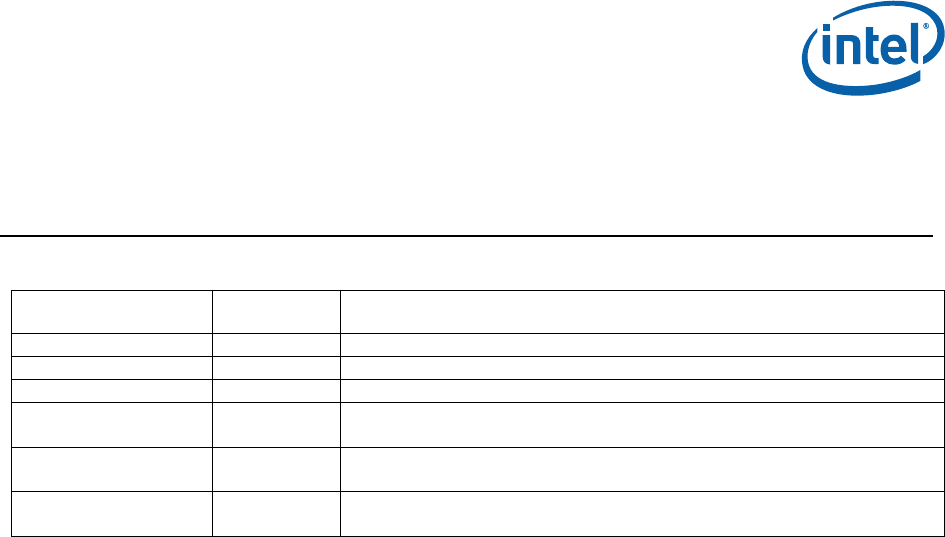
Contents-Real Time Instruction Trace
December 2015
Real Time Instruction Trace
Programming Reference v1.05
9
Revision History
Date Revision Description
February 2015 1.00 Initial Release
March 2015 1.01 Added read RTIT_CTL MSR requirement
June 2015 1.02 Added erratum E8.
June 2015 1.03 Fix erroneous text listing RTIT_LIP1 as a limit address and
RTIT_LIP2 as a base address
August 2015 1.04 Fix intro paragraph
Update RTIT_CTL.Dest bit behavior
December 2015 1.05 Call out BASE & MASK behavior more clearly
Document output write ordering semantics

Real Time Instruction Trace
Revision 1.05
Order Number: 332060-004
1 Introduction
This document describes the programming interface of Real Time Instruction Trace (RTIT), including
trace configuration options and trace output. RTIT is available only on 3rd generation Intel
®
Atom™
processor (code named Silvermont)-based and 4th generation Intel Atom processor (code named
Airmont)-based products, see 1.2 for details on which products are supported.
1.1 Overview
In current Intel
®
architecture, Last Branch Record (LBR) and Branch Trace Store (BTS) features allow
observance of internal CPU program flow. Branch information, i.e., the source and destination
instruction pointers, can be stored in a hardware stack, or written to memory via processor support.
Debug software can reproduce program flow based on the branch addresses and source code.
However, the overhead of using BTS is very significant, while LBR only captures the last several
branches only, both limitations that prohibit their use in real-time application debugging.
Real Time Instruction Trace (RTIT) works on the same principle as BTS and LBR. It operates in parallel
to the primary processor pipeline and uses a separate output streaming mechanism that is external to
the processor. This eliminates the limitations of existing debug mechanisms and allows continuous and
efficient runtime application debugging.
RTIT encodes and compresses program flow information, such as branch targets, branch taken/not
taken indications, and carries them to the memory subsystem in real time, avoiding the use of any
processor assist methods. The memory subsystem then forwards the RTIT data out to external
receivers for debug software to post-process and reconstruct program flow.
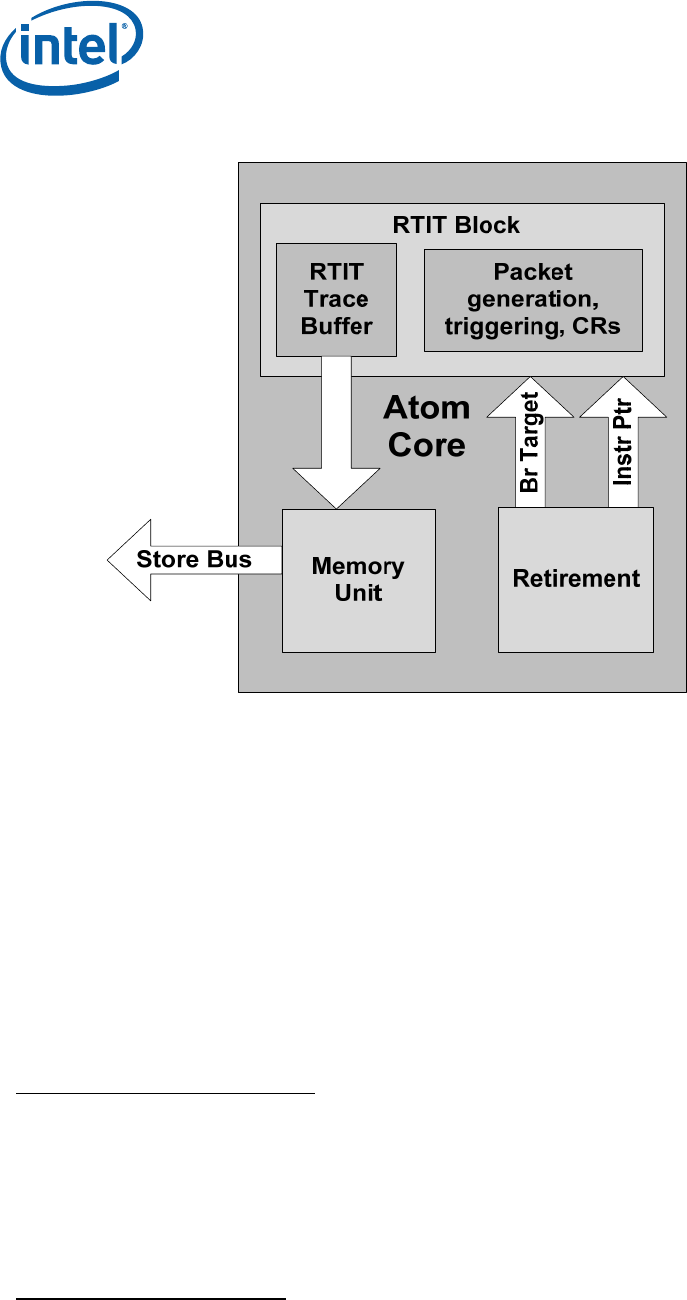
Real Time Instruction Trace
Real Time Instruction Trace
Programming Reference v1.05
December 2015
12
Figure 1: Real Time Instruction Trace Overview
Figure 1 shows how the RTIT logic fits into a System on a Chip (SOC) system. The RTIT Block
monitors the Intel
®
Atom™ processors core retirement pipeline and generates trace packets upon
retiring change of program flow instructions of interest. RTIT stores the traces in a trace buffer until
they are stored out to memory or to pins.
1.2 Availability and Use
The RTIT programming interface is available as model-specific feature only on certain Intel
®
Atom™
processors listed below. The definitions and usages of RTIT described in this document apply to those
processors models, in some cases, specific stepping. Intel
®
Atom™ processors supported by
Family/Model/Steppings are as follows:
Silvermont Microarchitecture:
0x6/0x37/0x8
0x6/0x5d/0x0
0x6/0x5d/0x1
0x6/0x4a/0x8
0x6/0x4d/0x8
0x6/0x5a/0x0
Airmont Microarchitecture:
0x6/0x4c/0x3

Real Time Instruction Trace
December 2015
Real Time Instruction Trace
Programming Reference v1.05
13
1.3 Features and Capabilities
RTIT generates a variety of packets that, along with the sources of a program, can be used to produce
an exact execution trace. The packets record information such as Linear and Target Instruction
Pointers (LIP and TIP) and direction of conditional branches within a contiguous code region (basic
blocks). In addition the packets record other contextual, timing, and bookkeeping information to
enable both functional and performance debugging of applications.
RTIT has several control and filtering capabilities to customize and compress the tracing information
collected and to append other processor state and timing information to enable debugging.
Programmable address comparison registers can be used to qualify RTIT output by
specifying different IP ranges and masks.
CPL and CR3 filtering modes allow filtering based on CPL execution mode (USER ring-3 or
SUP ring-0) and on CR3 values.
When enabled and appropriately configured, RTIT will collect and generate the following types of trace
information:
Packet stream Boundary (PSB) packets: The PSB acts as a ‘heartbeat’ that is generated at regular
intervals (e.g., every 8K trace packet bytes). PSB is a unique pattern, which allows decodes to sync
into a RTIT byte stream.
Taken Not Taken (TNT) packets: TNT packets track the “direction” of direct conditional branch
(i.e., taken or not taken). TNT packets are 1 byte, including the header. 1 to 6 TNT (Taken-Not-Taken
indications) can be packed in one TNT packet with a ‘1 signifying a taken branch and a ‘0 signifying a
not-taken branch that fell through to next instruction.
Target IP (TIP) packets: TIP packets record the target IP of indirect branches, exceptions, and
interrupt handlers. Up to 48 bits of IP can be stored, and the most significant bits that are identical to
the branch LIP or are entirely ‘0s can be suppressed to reduce the packet size.
Flow Update (FUP) packets: FUP packets record a variety of contextual information to aid in
decoding the trace output. These include:
BufferOverflowpackets (FUP.OVF)indicatethattheRTITinternalbufferisfullandthat
packetsarenolongerbeinggenerated.
PeriodicCycleCounter(FUP. PCC)isperiodicallygeneratedbasedonincrementsinacycle
counter.
PacketGenerationEnable(FUP.PGE)packetsaregeneratedwhenRTITisenabled,orif
the
executionentersaregionthatisconfiguredforRTITtracing.
PacketGenerationDisable(FUP.PGD)packetsaregeneratedwhenRTITtransitionsfroma
packetgeneratingmodeintoadisabledmodeduetofilteringcriterianotbeingmet,or
disablingRTIT.
FarTransfer(FUP.FAR)packetsaregeneratedafterafar
transferandwillincludeanaddress
indicatingwherethetransfercamefrom.ItisusuallygeneratedwithTIP,andappears
beforethecorrespondingTIPinthetraceoutput.

Real Time Instruction Trace
Real Time Instruction Trace
Programming Reference v1.05
December 2015
14
Paging Information Packet (PIP): PIP record any modifications to the CR3 register while memory
paging is enabled. This, along with process page information from the operating system, allows the
debugger to attribute linear addresses to their correct application source line.
Trace STOP (STOP) packets: STOP packets are generated when the current IP matches a region
specified by the ‘TraceStop’ filter.
Super Time Sync (STS) packets: STS packets are generated upon several processor frequency,
power, and other state global events. They will contain the value in the processor’s HW TSC, and
along with MTC are used by the debug analyzer to synchronize the traces with wall time.
Mini Time Counter (MTC) packets: MTC packets can be generated periodically based on the
processor’s HW TSC, and along with STS are used by the debug analyzer to synchronize the traces
with wall time.
Cycle Count Packet (CCP): CCP packets contain the incremental number of core cycles since the
previous CCP, and are generated after certain other trace packets based on the configuration of the
cycle accurate mode.
1.4 Using This Specification
Chapter 1: Introduction gives an introduction to RTIT, where it is available, and describes the
features and capabilities to customize tracing information based on user needs.
Chapter 2: RTIT Operational Model provides additional details about RTIT including the enabling
and filtering, and describes essential program flow concepts that form the basis of the RTIT tracing
model.
Chapter 3: Configuration and Control details the various mechanisms necessary for configuring,
enabling, controlling, and collecting RTIT data in an operating system or Virtual Machine Monitor.
Chapter 4: Trace Packets and Data Types details the packets generated by RTIT to assist
developers in decoding RTIT data and utilizing it to recreate an application execution trace.

Real Time Instruction Trace
December 2015
Real Time Instruction Trace
Programming Reference v1.05
15
2 RTIT Operational Model
This chapter describes the overall RTIT mechanism and explains essential concepts used throughout
the remainder of the document. Reading this chapter will provide a basic understanding of how RTIT
operates, and a detailed understanding of the various features and capabilities offered by RTIT.
This chapter is organized as follows: Section 2.1 explains the different circumstances and context
during which RTIT will be generating trace packets. Section 2.2 explains the notions of flow control
that are used by the RTIT mechanism to produce an execution trace. Section 2.3 describes the
primary mechanism for streaming RTIT packets. Section 2.4 describes the different filters that can be
used to restrict which execution streams are traced by RTIT. Section 2.5 gives an overall view of RTIT
programming and provides an example of such programming. Finally, Section 2.6 describes how RTIT
will behave while the processor is in non-standard execution modes.
2.1 RTIT Enables
RTIT has a variety of enables and disables that interact to ultimately decide if a packet should be
generated. This state is referred to as Packet Enable and is synonymous with PacketGenEnable, Packet
Generation Enable or PacketEn.
When Packet Enable is set, we are in the code that RTIT is monitoring and packets are being
generated to log what is being executed. PacketEn is composed of 4 other states according to this
relationship:
PacketEn = TriggerEn && ContextEn && FilterEn
Each of these states is detailed in the following subsections.
2.1.1 Trigger Enable (TriggerEn)
TriggerEn (Trigger Enable) is the primary indicator that RTIT is active. TriggerEn is defined using two
fields:
TriggerEn = (RTIT_CTL[Trace_En] AND RTIT_CTL[TraceActive]).
Software can get the current TriggerEn value by reading the RTIT_STATUS[TriggerEn] MSR bit. When
TriggerEn is clear, RTIT is inactive and no packets are generated.
2.1.2 Context Enable (ContextEn)
Context Enable (ContextEn) indicates that the processor is in the state that RTIT is configured to
watch. For example, if RTIT is configured to watch only application code (RTIT_CTL[OS]=0), then
ContextEn will be 0 when the CPU is in CPL0.

Real Time Instruction Trace
Real Time Instruction Trace
Programming Reference v1.05
December 2015
16
Software can get the current ContextEn value by reading the RTIT_STATUS[ContextEn] MSR bit.
ContextEn is defined as follows:
ContextEn = !(
(RTIT_CTL[OS]=0 AND CPL=0) OR
(RTIT_CTL[USER]=0 AND CPL=1,2,3) OR
(RTIT_CTL[CR3En]=1 AND RTIT_CR3_MATCH !=CR3) OR
(In SMM mode) OR
(In VMX mode))
When ContextEn is cleared, many packets are not generated, including all branch packets. However,
some packets, such as the MTC, may still be generated while ContextEn is clear.
2.1.3 Filter Enable (FilterEn)
Filter Enable indicates that the CPU Instruction Pointer (IP) is within the range of the IPs that RTIT is
configured to watch. See section 2.4.3 for details on IP filtering.
Software can get the state of Filter Enable by an MSR read of RTIT_STATUS[FilterEn].
Filter enable is only ‘usually’ correct because it may be incorrect if the RANGE0/1 ranges are not set
up correctly. It is also frozen when either Trace_En or ContextEn are 0.
2.2 Change of Flow Instruction Tracing
2.2.1 Basic Blocks
A program block is a section of code where no jumps or branches occur. The IPs in this block of code
need not be traced, as the CPU will execute them from start until end without redirecting code flow.
Instructions such as branches, and external events such as exceptions or interrupts, can change the
program flow. These instructions and events that change program flow are called COFI (Change of
Flow Instructions). The program block is divided into these three categories:
Direct transfer COFI.
Indirect transfer COFI.
Far transfer COFI.
The following subsections describe the IA architecture COFI events that result in trace packet
generation. For detailed description of the instructions, please refer to “Intel® 64 and IA-32
Architectures Software Developer’s Manual Volume 2A/2B: Instruction Set Reference.”
2.2.2 Direct Transfer COFI
These types of instructions include conditional jumps, and jumps that are to a Linear Instruction
Pointer (LIP) that is embedded in the instruction bytes. It is not necessary to output the LIP of the
destination address since it can be obtained through the source code. It is only necessary to indicate
whether the conditional branch is taken or not.
2.2.2.1 Jump if condition is met (Jcc) and LOOP
To track this type of instruction, RTIT uses a single bit of TAKEN or NOT TAKEN (TNT) to indicate the
program flow after the instruction. When the condition check is evaluated to true (i.e., the branch will

Real Time Instruction Trace
December 2015
Real Time Instruction Trace
Programming Reference v1.05
17
be taken), the processor IP will update to the target IP specified in the instruction. This is encoded as
TAKEN in the RTIT TNT packet; otherwise, the program will simply go to the next LIP, and is encoded
in the TNT as NOT TAKEN.
Jcc and LOOP can be traced with TNT bits. To improve the trace packet output efficiency, RTIT will
compact several TNT bits in a single packet. This can output up to 6 consecutive TNT bits in one TNT
packet.
2.2.2.2 Unconditional Direct Jumps
There is no RTIT output for direct unconditional jumps (like JMP near relative or CALL near relative)
since they can be directly inferred from the application assembly. Direct unconditional jumps do not
generate a TNT bit or a Target IP packet.
2.2.3 Indirect Transfer COFI
Indirect transfer instructions involve updating the LIP from a register or memory location. Since the
register or memory contents can vary at any time during execution, there is no way to know the
target of the indirect transfer until the register or memory contents are read. As a result, the
disassembled code cannot be used alone to determine the target of a COFI. Therefore, RTIT must
send out the destination LIP in the trace packet for debug software to determine the target address of
the COFI.
Indirect Transfer instructions will generate a Target IP packet (TIP) which contains the target linear
address of the branch or the new instruction pointer.
2.2.4 Near JMP Indirect and Near Call Indirect
As previously mentioned, the target of an indirect COFI resides in the contents of either a register or
memory location. Therefore RTIT must expose this target address to the debug software in order to
determine the target of the COFI.
2.2.5 Near RET
When a CALL instruction executes, it pushes the address of the next instruction following the CALL
onto the stack. Upon completion of the call procedure, the RET instruction is often used to pop the
return address off of the call stack and redirect code flow back to the instruction following the call.
A RET instruction simply transfers program flow to the address it popped off the stack. Because it is
possible for software to change the Extended IP (EIP) on the stack within the call procedure prior to
executing the RET instruction, the debug software can be misled if it always assumes code flow will
return to the instruction following the last call. Therefore, even for near RET, a Target IP Packet is
sent to handle this case.
A special case is applied if the target of the RET matches the Next LIP (NLIP) of the last CALL
instruction. Then only a single TNT bit of “Taken” is generated instead of a Target IP Packet.

Real Time Instruction Trace
Real Time Instruction Trace
Programming Reference v1.05
December 2015
18
2.2.6 Far Transfer COFI
All operations that change the instruction pointer which are not near jumps are “far transfers”. This
includes exceptions, interrupts, traps, and instructions that do far transfers (i.e. SYSENTER, SYSEXIT,
SYSCALL, SYSRET, software interrupts, far jump, far call, far RET and IRET).
Far transfers that produce RTIT packets will produce a Flow Update Packet of type Far Transfer
(FUP.FAR) followed by a Target IP packet (TIP); unless the far transfer also jumps out of the filtered
region while keeping ContextEn==1. A far transfer that causes FilterEn to become 0 but keeps
ContextEn at 1 will produce Flow Update packet of type PacketGenerationDisable (FUP.PGD instead of
FUP.FAR) followed by a Target IP packet. This is a form of compression and simplifies the hardware.
The following table indicates exactly which LIP will be included in the FUP.FAR or FUP.PGD generated
by a far transfer.

Real Time Instruction Trace
December 2015
Real Time Instruction Trace
Programming Reference v1.05
19
Table 1: IP Type in Various Packets
Event Flow Update LIP Note
Far CALL/JUMP
SYSENTER/SYSEXIT
SYSCALL/SYSRET
Far RET
IRET
Address of next instruction
(Next Linear Instruction
Pointer)
This does not match LBR FROM field, which
records the address of the branch
instruction. RTIT trace analysis does not
need this flow update packet since it should
know where the branch is, but it would
require more hardware to suppress it.
External Interrupt
NMI/SMI
Traps
Machine Check (trap-
like)
Address of next instruction
(NLIP) that would have
been executed
This matches the LBR FROM field value and
also the EIP value which is saved onto the
stack. Remember that LBRs are linear (not
effective) addresses for Intel
®
Atom™
processors.
INIT/SIPI Address of next instruction
(NLIP) that would have
been executed
Lower certainty on INIT and SIPI behavior.
Not important to RTIT usage.
(FUP.PGD only)
Walking out or region
Non-far transfer that
changes ContextEn to 0
Address of next instruction
(NLIP) that would have
been executed
LBRs have no such concept.
(FUP.PGD only)
Near jump out of region
Address of next instruction
(NLIP) that would have
been executed
This does not match the LBR field, which
would record the address of the branch
instruction.
Exceptions/Faults
Machine check (fault-
like)
Address of the instruction
which took the
exception/fault (Current
LIP)
This matches the LBR FROM field value and
also the EIP value which is saved onto the
stack.
Asynchronous Flow Update
Packet
Buffer Overflow
Periodic Cycle Counter
Address of next instruction
(NLIP/BLIP) that will execute
after the instruction where the
condition occurred
LBRs have no such concept.
PacketEn goes from 0 to 1
(includes VM-entry and
RSM)
Address of where we entered
region (BLIP or NLIP)
LBRs have no such concept.
VM-exit Address that is saved into the
VMCS as guest RIP
LBRs have no such concept.
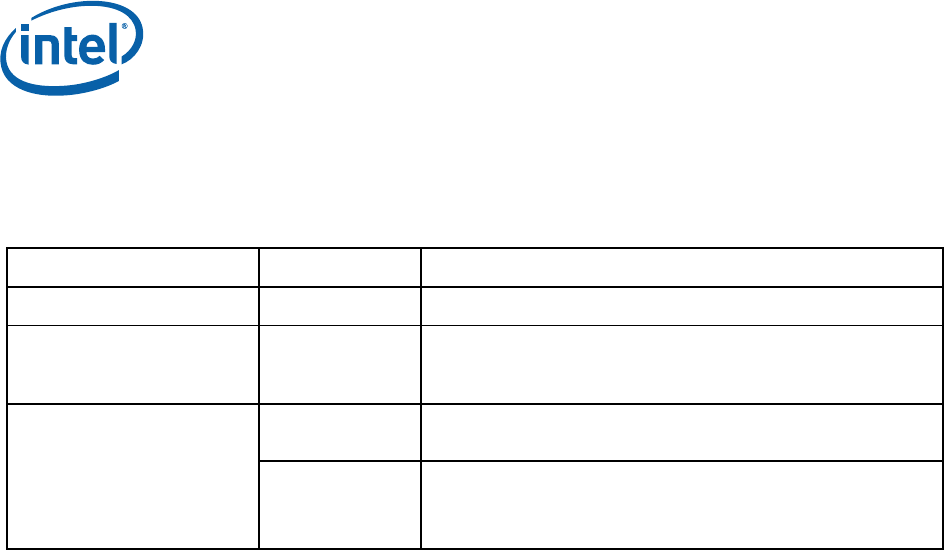
Real Time Instruction Trace
Real Time Instruction Trace
Programming Reference v1.05
December 2015
20
2.2.7 Flow Control Packet Summary
The following table summarized the trace packets as per each instruction
Table 2: Classifying branches and COFI
Instruction Packet Note
Jcc/LOOP TNT Branch taken/not taken packet.
Near Jump (indirect)
Near Call (indirect)
Near RET
Target IP Branch destination LIP(BLIP) is sent in target IP
Packet.
Far Transfers, including:
Far Jump/CALL
Far RET/IRET
Exception/Interrupt/Trap
SYSENTER/SYSEXIT
SYSCALL/SYSRET
Flow Update LIP before the far transfer. Same as recorded in LBRs
(or would be pushed onto stack).
Target IP Branch destination LIP(BLIP) is sent in target IP
Packet.
2.3 Trace Output
RTIT packet data is written by the CPU to the memory subsystem. RTIT writes use the USWC memory
type, regardless of what is specified by the MTRRs. The use of platform physical addressing means
that RTIT writes are not affected by page tables or EPT tables.
The RTIT output destination is specified by writing a platform physical address to the
RTIT_BASE_ADDR MSR to serve as the destination base, and a mask value to the RTIT_LIMIT_MASK
MSR to dictate the size of the region. The RTIT_BASE_ADDR value should be aligned to the size of the
output region (RTIT_LIMIT_MASK+1), as the base value used will be RTIT_BASE_ADDR &
~RTIT_LIMIT_MASK.
The RTIT_OFFSET MSR holds the offset into the region specified by RTIT_BASE_ADDR and
RTIT_LIMIT_MASK. Thus the physical address to which RTIT stores are directed is computed as
follows:
RTIT_BASE_ADDR + (RTIT_OFFSET & RTIT_LIMIT_MASK)
Note that the buffer is treated as circular, and hence once the offset value reaches the mask value,
writes will wrap around and write at offset 0 again.
2.3.1 Debug Port
In order to send RTIT output to a debug port, the platform-specific memory-mapped I/O (MMIO)
address for the port of interest should be written to the RTIT_BASE_ADDR MSR, with the
RTIT_LIMIT_MASK value set to match the size of the desired MMIO range. As described above, RTIT
output will be written to this address range in a circular fashion.
Please see SoC documentation to determine which debug port options exist for your platform.

Real Time Instruction Trace
December 2015
Real Time Instruction Trace
Programming Reference v1.05
21
2.3.2 Output Write Behavior
RTIT output writes pass through the memory subsystem, and like other memory writes RTIT output is
written out in 64 byte lines. In some cases, it is possible to observe partial line writes of RTIT data.
This can result from enabling trace with an unaligned RTIT_OFFSET value (which would cause output
to begin in the middle of the line), or from a fencing operation causing a line to be written out before
it is filled (which would cause the RTIT bytes to cease before the end of the line). RTIT disable or bus
locks are examples of operations that could prematurely flush an RTIT line. The implication is that it
is possible to see individual RTIT writes that may include invalid bytes at the beginning and/or at the
end of the line. However, as long as RTIT_OFFSET is not manipulated by software, the resulting
output will be contiguous and non-overlapping.
USWC writes, like those employed by RTIT, are not strongly ordered, and thus it is possible (though
rare) to observe a younger line written to its endpoint before an older line. When an RTIT drain is
executed (e.g., on write to RTIT_CTL), all RTIT writes are fenced, and hence any re-ordering should
have no effect on the resulting output bytes. For this reason it is recommended that collectors always
disable RTIT before collecting trace output. If RTIT output is examined or collected before a drain is
executed, as is typical when writes are directed to a trace hub or arbiter, the collector may need to be
able to re-order any out-of-order writes. In such a case, please refer to the corresponding spec for
the trace hub employed to determine the possibility of receiving out-of-order RTIT writes from the
CPU.
When out-of-order RTIT writes are exposed, the degree of software re-ordering required is limited.
Let us enumerate the lines comprising the output region as A, B, …, n, such that line A is the first 64-
byte line in the buffer, and n is the last. Software can discern which line has been received by
examining the address bits offset from the output base address in RTIT_OUTPUT_BASE. In this
scenario, we’ll define an “iteration” as the sequence of writes to A..n before the output wraps back to
A. Using line B as an example, it is possible that, before a given iteration of B is seen, younger lines
C..n from the same iteration may be seen. It is even possible that the next iteration of A could be
seen before B. However, it is not possible to first see a younger iteration of B, nor any still younger
lines (e.g., next iterations of C..n).
2.4 Trace Filtering
2.4.1 Filtering by Current Privilege Level (CPL)
RTIT provides the ability to specify whether tracing occurs when code is executing in CPL0 or not. RTIT
can be configured to be enabled only when in CPL0, when in CPL1/2/3, or at all CPLs. When in a non-
enabled CPL, the Context Enable is cleared.
The CPL value that is used to determine the RTIT Context Enable is read after instruction retirement.
This means that speculative CPL changed will not affect the RTIT state. For example, a page fault
which triggers a change of CPL from 3 to 0 will not send out a TIP packet if RTIT is configured to only
monitor CPL 1/2/3. A FUP packet will still be generated to indicate a traced region was left.
2.4.2 Filter by CR3
To reduce the total trace size, it is important to be able to trace a single application without requiring
software intervention every time applications are switched.
Since CR3 (the page table pointer) is the primary piece of CPU state that indicates which application is
running, RTIT can enable or disable tracing depending on the CR3 value. This is done through the CR3
filtering/matching feature.

Real Time Instruction Trace
Real Time Instruction Trace
Programming Reference v1.05
December 2015
22
If the RTIT user desires to only trace a single CR3, then they can program that CR3 value into
RTIT_CR3_MATCH MSR and set RTIT_CTL.CR3En. When the CR3 value does not match that in
RTIT_CR3_MATCH, the processor will disable RTIT (ContextEn forced to 0). When the CR3 value does
match of RTIT_CR3_MATCH, then the processor will stop disabling RTIT because of the CR3 value
(although it could remain disabled due to other filters like CPL). If RTIT_CTL.CR3En is 0, then all CR3s
are monitored (RTIT tracing is not disabled by the CR3 value).
The Paging Information Packet is sent out in various situations to explain to the analyzer which app is
being executed. When a non-paging mode is entered (CR0.PG is cleared), a paging information packet
is generated. This will not affect the current CR3 filtering because it is not a direct change in the value
of CR3.
OS-specific techniques will need to be used to discover the CR3 value that corresponds to a particular
already-running application. If the application can only be started when RTIT is already running, other
techniques (like OS debug hooks, OS modification or using a special driver) may need to be used to
discover the CR3 value and subsequently update the RTIT CR3 filters.
2.4.3 Filtering by IP
RTIT can be configured to enable control flow packet generation only when the CPU is executing code
within certain IP ranges. This is controlled with FilterEn, which, if IP filtering is enabled, is set only
when the IP is in one of the ranges specified by SW. If the IP is outside of these ranges, then FilterEn
is cleared and no control flow packets are enabled.
IP filtering is enabled using the RTIT_EVENTS MSR. This MSR configures use of the RTIT_LIP[0123]
MSRs, which are used to define the base and limit of the range(s) in which tracing is enabled. Current
RTIT implementations have 2 such ranges, known as RANGE0 and RANGE1. RANGE0 is defined by
[RTIT_LIP0..RTIT_LIP2-1], while RANGE1 is defined by [RTIT_LIP1..RTIT_LIP3-1].
EventIDs are used for IP filtering, and for TraceStop. RTIT_EVENTS[Filter Event ID] and
RTIT_EVENTS[Stop Trace Event ID] are programmed with event ID encodings, which are details in
section 3.3.5. Note that the Filter event ID and TraceStop event ID are two separate fields, and thus
different conditions can cause those actions.
To save power, the comparison of the IP to the RANGE0/1 ranges is done only when
RTIT_CTL[Trace_En] is set. This means that the FilterEn value will not be changed by the IP when
Trace_En is cleared. This means that leaving Trace_En set but disabling RTIT by having Trace_Active
cleared consumes more power than if Trace_En was also cleared.
It is important to note that, though no control flow packets are generated from outside of the IP filter
ranges, some packets can be generated at this time. Periodic packets, such as MTC and PSB, can still
be generated when FilterEn is 0.
2.5 Trace Programming
RTIT provides the end-user with a highly configurable set of tracing capabilities and programmable
events for both performance analysis and debug. RTIT is configured through code execution via the
WRMSR and RDMSR instructions.
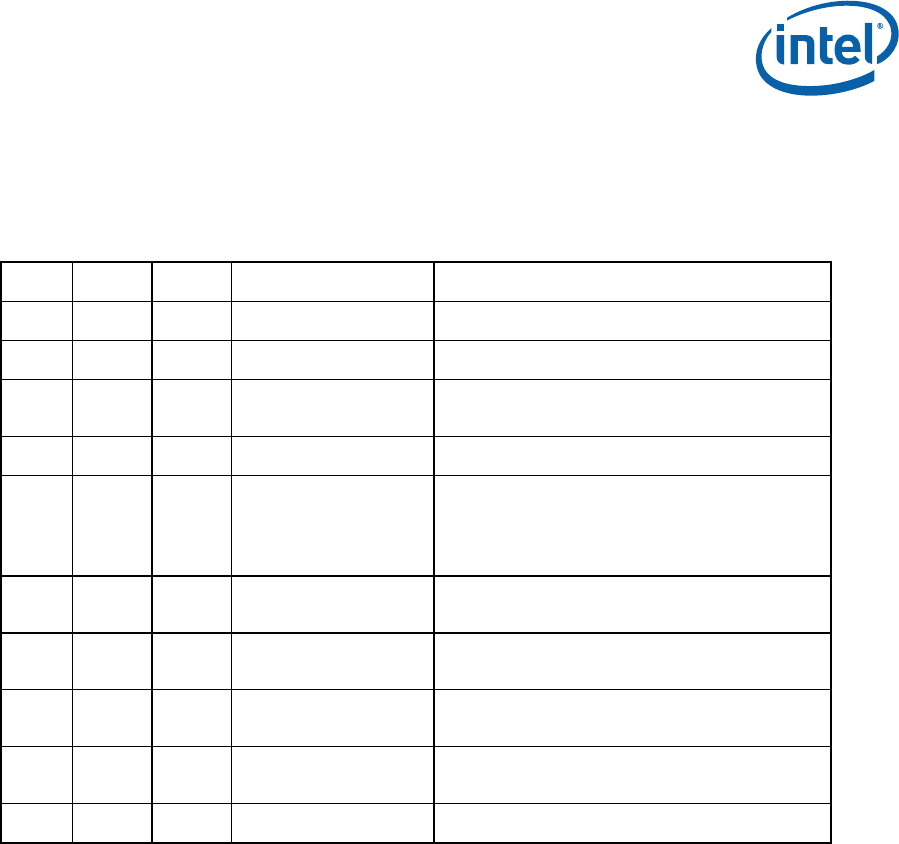
Real Time Instruction Trace
December 2015
Real Time Instruction Trace
Programming Reference v1.05
23
2.5.1 Trace Example
If RTIT was programmed to trace all CPLs and the address filters were restricting the IP range to
instruction between 0x100-0x110, then the following RTIT packets would be generated:
Table 3: RTIT Trace Example
Step
CLIP NLIP Instruction
RTIT output
1 0x020 0x023 Jmp to 102
1. FUP.PacketGenEnable of 102 (BLIP)
2 0x100 0x102 Xor eax, eax
Nothing
3 0x102 0x105 Far JMP to 983
1. FUP.PacketGenDisable of 105 (NLIP)
2. TIP of 983 (BLIP)
4 0x983 0x985 Far JMP to 10E
1. FUP.PacketGenEnabled of 10E (BLIP)
5 0x10E 0x113 Divide that causes
Divide by 0 fault
Fault handler at
345
1. FUP.PacketGenDisabled of 10E (NLIP)
2. TIP of 345 (BLIP)
6 0x345 0x348 Add (first instr of
fault handler
Nothing
7 348 34c POP ret address to
RAX
Nothing
8 34c 350 Modify RAX to point
to 113
Nothing
9 350 353 PUSH new ret addr
of 113 onto stack
Nothing
10 353 357 IRET to 113
Nothing (since 113 is outside of range)
2.6 Interaction with Other Components
2.6.1 System Management Mode
RTIT is always disabled during System Management Mode (SMM). Whenever a System Management
Interrupt (SMI) occurs, the CPU will set an internal “We are in SMM mode” bit that will force
ContextEn to become 0 if it was not already 0. If this caused PacketEn to transition from 1 to 0, then a
FUP.PGD will be sent out with the address of the next instruction that would have executed had the
SMI not occurred. A TIP packet is never generated on an SMI since the SMI results in ContextEn is 0
(and any operation that disabled ContextEn does not send out a TIP).
Whenever an RSM occurs, the CPU will clear the internal “We are in SMM mode” bit, which will thus
stop forcing ContextEn to 0. In the normal case, this will cause ContextEn to return to the value that it
was before the SMI. If that causes PacketEn to transition from 0 to 1, then a FUP.PGE will be
generated with the address of the target of the RSM (the next instruction to execute after the RSM). If
the SMM return address was not modified, this will usually be the same address as was seen on the
FUP.PGD generated on the preceding SMI.

Real Time Instruction Trace
Real Time Instruction Trace
Programming Reference v1.05
December 2015
24
As discussed earlier, the software SMM handler could do various things that would cause the RSM to
return to a different instruction or mode than was executing before the SMI. For example, it could
change the return address to be outside of the filtered region when it was inside the filtered region
before the SMI. Or it could change the CR3 value.
The RSM simply clears the “We are in SMM mode” bit that was forcing ContextEn to 0. FilterEnable
and the CPL will also be re-evaluated automatically based on the processor settings mode that the
RSM is loading (whether it was the same as that before the SMI or not).
The RSM re-evaluates whether the CR3 matches the RTIT_CR3_MATCH MSR, and determines the SMI
does not. Therefore, it is not needed on the SMI since the SMI will clear ContextEn and it cannot be
set until the RSM occurs.
2.6.2 Virtual Machine EXtensions
RTIT is always disabled in Virtual Machine EXtensions (VMX) host mode (this mode is also referred to
as VMM, root mode, or the hypervisor).
Whenever a VM exit occurs, the CPU will set an internal “We are in VMM mode” bit that will force
ContextEn to become 0 if it was not already 0. If this caused PacketEn to transition from 1 to 0, then a
FUP.PGD will be sent out with the address that is saved into the VMCS as the RIP. A TIP packet is
never generated on a VM exit since the VM exit results in ContextEn of 0 (and any operation that
disabled ContextEn does not send out a TIP).
Whenever a VM entry occurs, the CPU will clear the internal “We are in VMM mode” bit, which will thus
stop forcing ContextEn to 0. In the normal case, this will cause ContextEn to return to the value that it
was before the VM exit. If that causes PacketEn to transition from 0 to 1, then a FUP.PGE will be
generated with the address of the target of the VM entry. If the VMCS guest RIP field was not
modified, this will usually be the same address as was seen on the FUP.PGE generated on the
preceding VM exit. VM entry will re-evaluate whether CR3 matches RTIT_CR3_MATCH.

Real Time Instruction Trace
December 2015
Real Time Instruction Trace
Programming Reference v1.05
25
3 Configuration and Control
This chapter details the mechanism for configuring, enabling and controlling the operation of RTIT. It
is intended for developers who are writing software to support RTIT operation, whether in the OS/VMM
or in the debug controller. This section can also be used as a reference for programming the relevant
RTIT MSRs.
3.1 Enumeration
For Intel
®
Atom™ processors, RTIT is not architectural and is therefore not enumerated in any way.
To determine if the processor does support RTIT, the user can verify the Family, Model, and Stepping,
and then use a try-accept to test for RTIT functionality.
3.2 RTIT accessibility
RTIT is configured via model-specific registers (MSRs). These can be controlled through either JTAG
or ring-0 software. For details about JTAG access, please contact your Intel sales representative.
3.3 CPU Control and Model-Specific Registers
3.3.1 General MSR notes for RTIT
All RTIT MSRs are described below, and are duplicated per logical processor. Until the RTIT_CTL
MSR (0x768) has been read any attempt to write any RTIT MSR, or read any RTIT MSR
other than RTIT_CTL, will result in a #GP fault.
For all RTIT MSRs, any MSR write that attempts to change (which usually means ‘set’) bits marked
reserved will cause a #GP fault. RTIT MSRs are not cleared by INIT.

Real Time Instruction Trace
Real Time Instruction Trace
Programming Reference v1.05
December 2015
26
3.3.2 RTIT_CTL MSR
Table 4: RTIT CTL Control Register
Bit Name Description
0 Trace_En GlobalEnableDisable
1 Cycle_Acc 0:CycleAccurateModeisDisabled
1:CycleAccurateModeisEnabled
2 OS 0:IndicatesOSlevelCOFIwillnotbetraced
1:IndicatesOSlevelCOFIwillbetraced
3 User 1:IndicatesUSERlevelCOFIwillbetraced
0:IndicatesUSERlevelCOFIwillnotbetraced
4 STS_on_CR3 GeneratesSTSpacketonCR3changes
[6:5] Rsvd Reserved
7 CR3En 0:DisablesCR3Filtering
1:EnablesCR3Filtering
8 Dest 0:ForceTraceStoptobewrittentoaddressoffset0xC0.See
detailsbelow.
1:NospecialtreatmentofTraceStoppacket
9 MTC_En 0:MTCpacketgenerationdisabled
1:Enabled
10 STS_En 0:STSpacketgenerationdisabled
1:Enabled
11 Cmprs_Ret CompressesReturnaddress
12 Less_Pkts Generatelesspacketstoimprovebandwidth
13 TraceActive ThisisanotheroverallRTITvalidbitwhichneedstobeset
forTriggerEnabletobe1(justlikeRTIT_CTL.Trace_En).Itis
differentfromTrace_Eninthatitcanbeclearedbythe
TraceStopaction.AnMSRwritethatclearsTraceActive
shouldnotcauseaTraceStoppacket,however.
[15:14] MTC_Range DefinesTSCgranularity
00:TSC[14:7]
01:TSC[16:9]
02:TSC[18:11]
03:TSC[20:13]
[31:16] Reserved Reserved
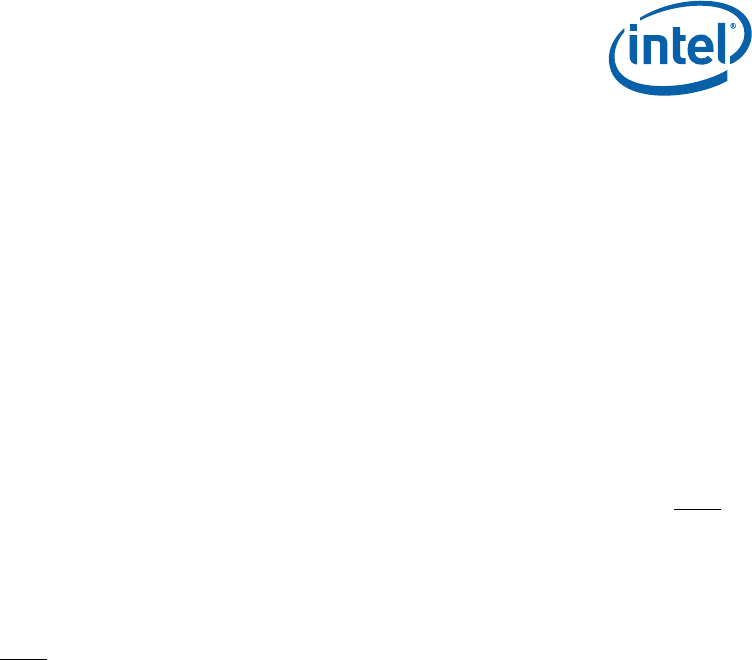
Real Time Instruction Trace
December 2015
Real Time Instruction Trace
Programming Reference v1.05
27
RTIT_CTL [0]: Trace_En
Trace_En globally turns on or off the RTIT architecture. The reset value of Trace_En is 0, disabling
RTIT by default.
It is recommended that software set Trace_En before setting TraceActive (below) when enabling
tracing. Similarly, software should clear TraceActive before clearing Trace_En when disabling tracing.
If both Trace_En and TraceActive transition 0->1 or 1->0 in the same WRMSR, undefined behavior
may result.
RTIT_CTL [1]: CYCLE_ACC
CYCLE_ACC enables or disables the cycle accurate mode of RTIT COFI tracing. When set (1’b1), a
cycle count packet is appended to all outbound RTIT traffic with the exception of the PSB packet.
RTIT_CTL [2]: OS
The OS bit is used to indicate that whether CPL0 code (usually OS code) should be traced. See 2.4.1.
When this bit is cleared and the current CPL is 0, then the ContextEn will be 0 (which disables many
things, including COFI packets).
RTIT_CTL [3]: USER
The USER bit is used to indicate whether CPL1, CPL2, and CPL3 code (usually application code) should
be traced or not. See 2.4.1. When this bit is cleared and the current CPL is 1, 2 or 3 (>0), then the
ContextEn will be 0 (which disables many things including COFI packets).
RTIT_CTL [4]: STS_on_CR3
This bit being set will cause Super Time Synch Packets to be sent out on MOV CR3 operations
RTIT_CTL [6:5]: Reserved.
RTIT_CTL [7]: CR3En
When this bit is set, CR3 filtering is enabled and ContextEn will be zero if the CR3 value does not
matches what is in RTIT_CR3_MATCH MSR. When ContextEn is 0, COFI packets are not generated.
When this bit is cleared, the CR3 value RTIT_CR3_MATCH do not affect ContextEn. This behavior is
described in more detail in the “Tracing one app (CR3 filtering)” section.
RTIT_CTL [8]: Dest
Controls treatment of the TraceStop packet. When cleared, the write of the TraceStop packet will
force the lower 8 bits of the write address to 0xC0. This should only be used when RTIT output is
directed to dedicated trace hardware such as PTI, on SoCs that support such specialized TraceStop
treatment.
When set, there is no special treatment of the TraceStop packet. This mode supports output to DRAM,
or to dedicated trace hardware such as PTI.
RTIT_CTL [9]: MTC_En
Used to enable or disable the Mini Time Counter. See Mini Time Counter (MTC) Packet section for
more details.

Real Time Instruction Trace
Real Time Instruction Trace
Programming Reference v1.05
December 2015
28
RTIT_CTL[10]: STS_En
Used to enable or disable Synch packet generation. A value of ‘1’ enables STS packet generation,
while a value of ‘0’ disables STS packet generation.
RTIT_CTL [11]: CMPRS_RET
Setting this bit changes the behavior of indirect transfer packet generation. When set, near RET
instructions may be compressed against the NLIP of the preceding call. See Indirect Transfer
compression for returns (RET) section for more details.
RTIT_CTL [12]: LESS_PKTS
The LESS_PKTS bit is used to decrease the number of packets generated and thereby decrease
bandwidth demands. Please refer to the following table for a complete representation of which
packets are inhibited when LESS_PKTS is set. Enable Groups and Packet Generation.
RTIT_CTL [13]: TraceActive
The TraceActive bit must be set before anything in RTIT occurs because it is part of TriggerEnable.
Thus when TraceActive is 0, TriggerEnable is 0 (and RTIT is off). It is cleared by TraceStop action and
is settable only by an MSR write (e.g. WRMSR).
As described in the Trace_En section above, TraceActive should only be modified while Trace_En is
set.
RTIT_CTL [15:14]: MTC Range
MTC Count allows the user to specify which bits of the TSC will become bit 15:8 of the MTC packet as
follows:
MTC Range Resulting TSC in MTC packet
00 TSC[14:7]
01
TSC[16:9]
02
TSC[18:11]
03
TSC[20:13]
RTIT_CTL[31:16] Reserved.
MSR writes to any reserved bits results in a #GP0 fault.
MSR writes to RTIT_CTL will cause an RTIT drain and will not end until that drain is completed and all
RTIT stores are globally observed. This ensures that any changes to RTIT_CTL are visible in memory
by the time the MSR write completes. Thus, if software turns off RTIT by clearing TraceActive, it can
count on fields like RTIT_OFFSET to be correct and constant after the MSR write.
A write to RTIT_CTL that causes RTIT_STATUS[TriggerEn] to become set (meaning that
RTIT_CTL[Trace_En] and RTIT_CTL[TraceActive] are both set and one of them was not set before) will
cause the PSB packet to be sent out.
An MSR write to RTIT_CTL that causes PacketEn to become 0 (e.g. by clearing OS or USR or by setting
CR3En) will cause a FUP.PGD packet to be generated. An MSR write that causes PacketEn to become 0
by clearing TraceActive or Trace_En may not generate a FUP.PGD. See the FUP.PGD section for more
details.

Real Time Instruction Trace
December 2015
Real Time Instruction Trace
Programming Reference v1.05
29
An MSR write to RTIT_CTL that causes PacketEn to become 1 will cause a FUP.PGE packet to be sent.
The MSR address is 0x768. Reset value = 0.
3.3.3 RTIT_STATUS MSR
RTIT_STATUS can be read or written by software, but some bits (like ContextEn) are read-only and
cannot be modified directly. Any writes that attempt to modify these read-only bits will have no effect
on the value; but will not cause a #GP (they are not checked as reserved bits).
The MSR address is 0x769. Reset value=0.
RTIT STATUS [0]: FilterEn
This is the bit that is set upon entering a tracing region and cleared upon leaving a tracing region. It
indicates that the IP is within the filtered regions (but can be manipulated). It is one of the three
enables that make up Packet Enable.
RTIT STATUS [1]: ContextEn
This is the context enable bit. It is set when we are in the right context for tracing (e.g. correct CPL,
CR3 value, not in VMM/SMM, etc.) It is one of the three enables that make up Packet Enable. It is
read-only.
RTIT STATUS [2]: TriggerEn
This is the trigger enable bit. It is set when RTIT is overall enabled (RTIT_CTL[Trace_En] AND
RTIT_CTL[TraceActive]). It is one of the three enables that make up Packet Enable and is read-only.
RTIT STATUS [3]: Buffer_Overflow
This bit indicates that there is currently a buffer overflow that is pending. Under certain circumstances,
software may need to context-switch that information.
It is read/write and can be updated directly by the processor or by software through MSR writes.
RTIT STATUS [31:4]: RESERVED
MSR writes to any reserved bits result in a #GP0 fault.
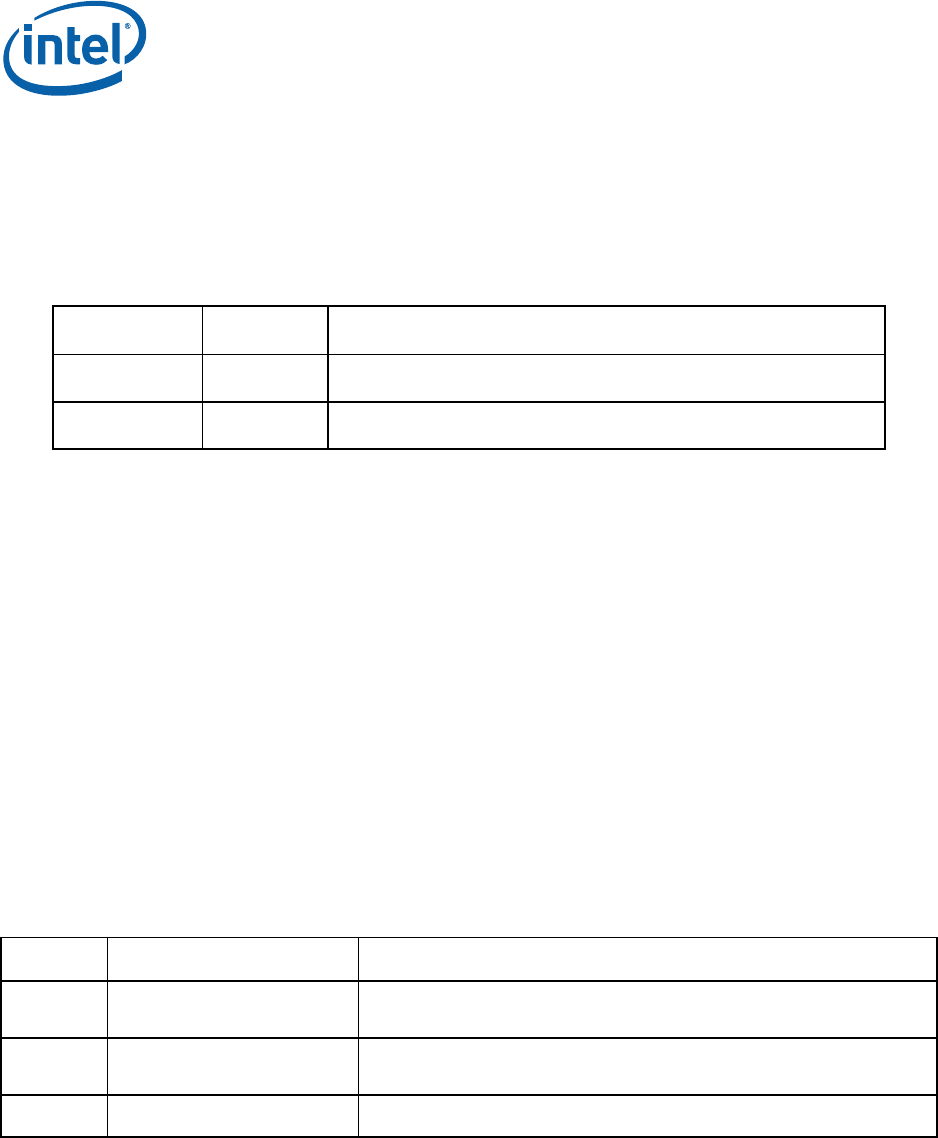
Real Time Instruction Trace
Real Time Instruction Trace
Programming Reference v1.05
December 2015
30
3.3.4 RTIT_CNTP MSR
The MSR address is 0x76B. Reset Value: 22'b0
Table 5: Cycle Counter
Bit Name Description
[ 21 : 0 ] CNTP Count is a 22-bit incrementing counter value
[ 31 : 22] Reserved Reserved
CNTP is a 22-bit incrementing counter that counts up at a rate equal to the processor core clock.
CNTP can be used to generate info on cycle count between packets in cycle accurate mode. More
details of this counter are in the “Cycle Counter” section.
The counter value CNTP is reset back to 22’b0, when
CPU reset occurs (warm or cold)
CNTP overflows
A packet is sent out with a cycle count (the current value of CNTP). This occurs on almost
every packet sent out in Cycle Accurate mode (RTIT_CTL[Cycle_Acc]).
The RTIT hardware will attempt to send out a Periodic Cycle Count (FUP.PCC) Packet when the MSB
(bit 21) of CNTP is set and it is in the appropriate mode. For more details, see the “Flow Update event:
Packet Cycle Counter” section.
3.3.5 RTIT_EVENTS MSR
The MSR address is 0x76C. Reset Value: 32'b0.
Table 6: RTIT Filter Enable
Bit Name Description
[2:0] Filter_Event_ID EventID which will control RTIT_STATUS.FilterEn (Filter
Enable mode bit)
[5:3] TraceStop_Event_ID EventID which will cause a TraceStop action (Stops Tracing
by clearing RTIT_CTL.TraceActive)
[31:6] Reserved Reserved
RTIT_EVENTS provides a means to conditionally enable RTIT based on the user defined events.
Filter Event_ID allows the user to specify for which IPs FilterEnable should be set and for which it
should be clear.
TraceStop Event_ID allows the user to specify which IPs should cause the TraceStop action. The
TraceStop action stops tracing (by clearing RTIT_CTL.TraceActive it causes TriggerEn to become 0)
and also causes a TraceStop packet to be generated.
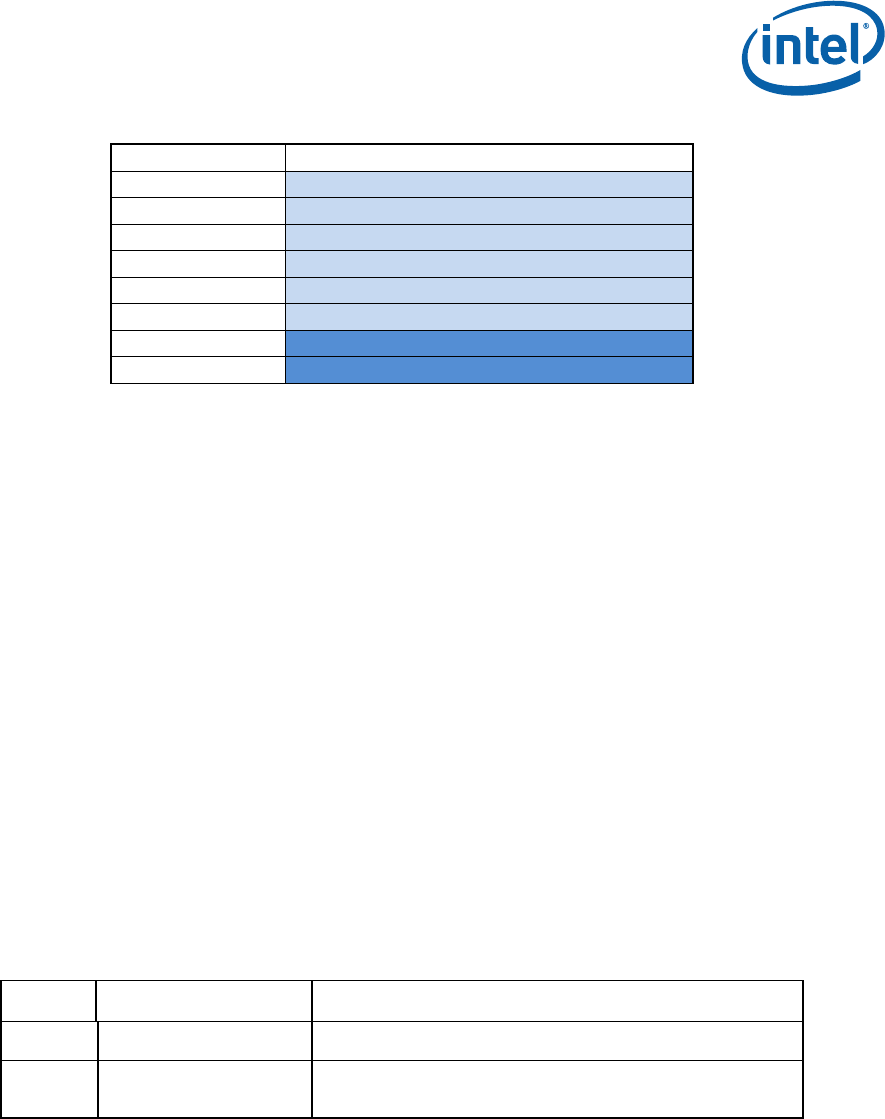
Real Time Instruction Trace
December 2015
Real Time Instruction Trace
Programming Reference v1.05
31
Table 7. RTIT Event IDs
EventID Event Name
000 RANGE0
001 RANGE1
010 RANGE0 || RANGE1
011 Reserved
100 Reserved
101 Reserved
110 Always off
111 Always on
The table above describes the event IDs that can be programmed to either the Filter_Event_ID or the
TraceStop_Event_ID. RANGE0 is defined as [RTIT_LIP0..RTIT_LIP2-1], while RANGE1 is defined as
[RTIT_LIP1..RTIT_LIP3-1]. When RANGE0 and/or RANGE1 is used for one of these fields, this means
that software that either executes an instruction at the base IP (specified by RTIT_LIP0 or RTIT_LIP1),
or executes a taken branch or event whose target is within the range, will trigger the chosen behavior,
be it FilterEn assertion to enable tracing, or TraceStop. Correspondingly, software that executes an
instruction at the limit IP (RTIT_LIP2 or RTIT_LIP3), or a taken branch or event whose target is
outside the range, will cause the CPU to detect that software has left the range.
This means that if RTIT is enabled from within RANGE0 or RANGE1, the CPU will not trigger the
FilterEn or TraceStop behavior until either the IP at the range base is executed, or until a taken
branch or event lands within the range. If neither of these occurs before the software executes the IP
at the limit of the range, no triggering will occur.
Note that behavior when RANGE0 and RANGE1 overlap, or when the range base is greater than the
range limit, is undefined. Software should avoid such scenarios, as undesirable behavior is likely to
ensue.
3.3.6 RTIT_LIP0-3 MSR
MSR numbers are 0x760, 0x761, 0x762, 0x763. Reset Value: 64’b0
Table 8: RTIT LIP0-3 Address Range Comparators
Bit Name Description
[47:0] LIPN_ADDR Holds the LIP for comparison for TraceLIPN
[63:48] LIP_SIGN_EXT Reads return the sign-extended value of bit 47 for
each bit in this field. Writes to it have no effect.
These MSRs serve to define the base and limit values for RANGE0 and RANGE1. See the
RTIT_EVENTS MSR for more details.
Note that reads of this MSR will return 0 for the LIP_SIGN_EXT field.
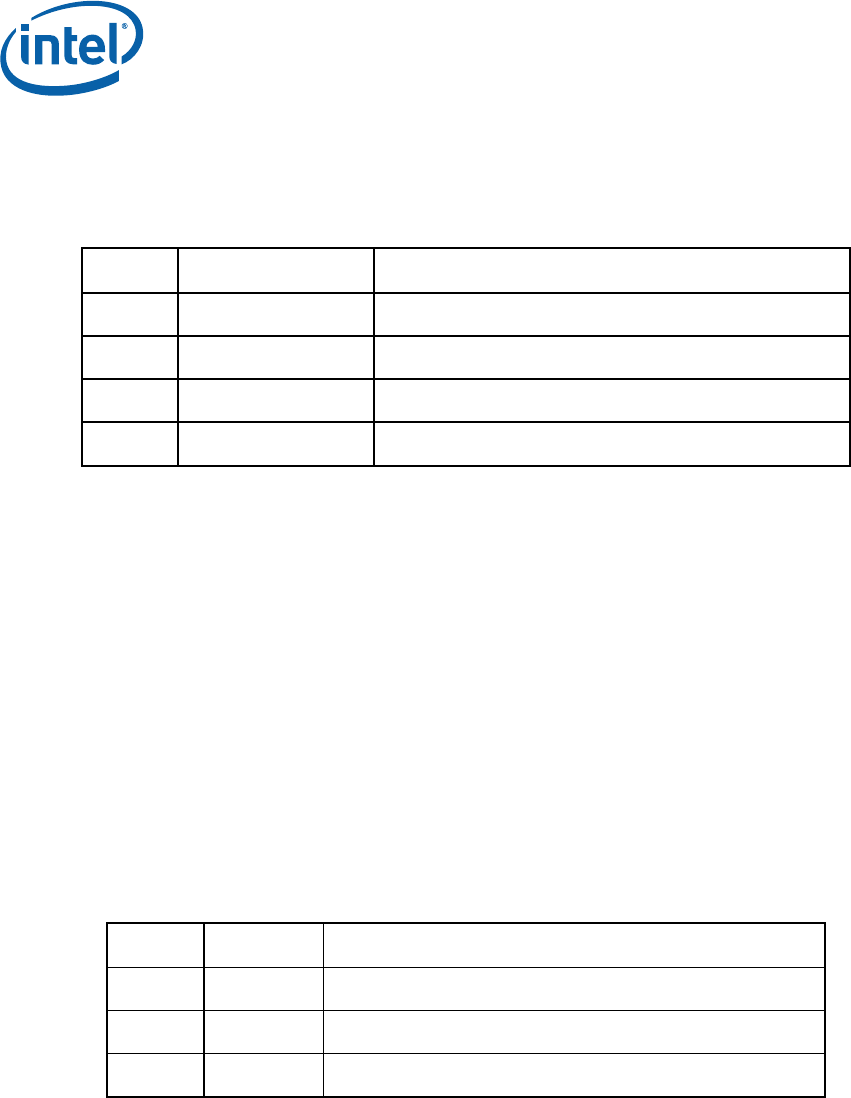
Real Time Instruction Trace
Real Time Instruction Trace
Programming Reference v1.05
December 2015
32
3.3.7 RTIT_LAST_LIP MSR
The MSR address is: 0x76E. Reset Value: 64’b0.
Table 9: RTIT Last LIP
Bit Name Description
[15:0] CMPRS_LIP_LOW Holds LIP[31:16] of the compressed LIP
[31:16] CMPRS_LIP_HIGH Holds LIP[47:32] of the compressed LIP
[32] CMPRS_LIP_Valid Indicates the compressed LIP values are valid
[63:33] Reserved Reserved as 0
LIP Compression compares the LIP being sent out with the last LIP sent out, so only 16-bit
chunks which change are sent out. This further reduces the bandwidth requirements required
by RTIT.
LIP Compression applies to the Flow Update Packets (FUP) and Target IP Packet.
o Compressed LIP High (CLH) is compared against LIP[47:32] of the packet being
generated, while Compressed LIP Low is compared against LIP 31.
This entire MSR is cleared to 0 (reset value) when a PSB packet is generated and when a buffer
overflow packet is generated.
3.3.8 RTIT_CR3_MATCH MSR
RTIT CR3 Match registers have the programmed CR3 value for trace filtering. The bits correspond to
that defined in CR3 MSR. The MSR address is: 0x777. Reset Value: 64’b0.
Table 10: RTIT CR3 Comparator
Bit Name Description
[63:36] Reserved Reserved
[35:5] CR3[35:5] Matches contents of CR3 [35:5]
[4:0] Reserved Reserved
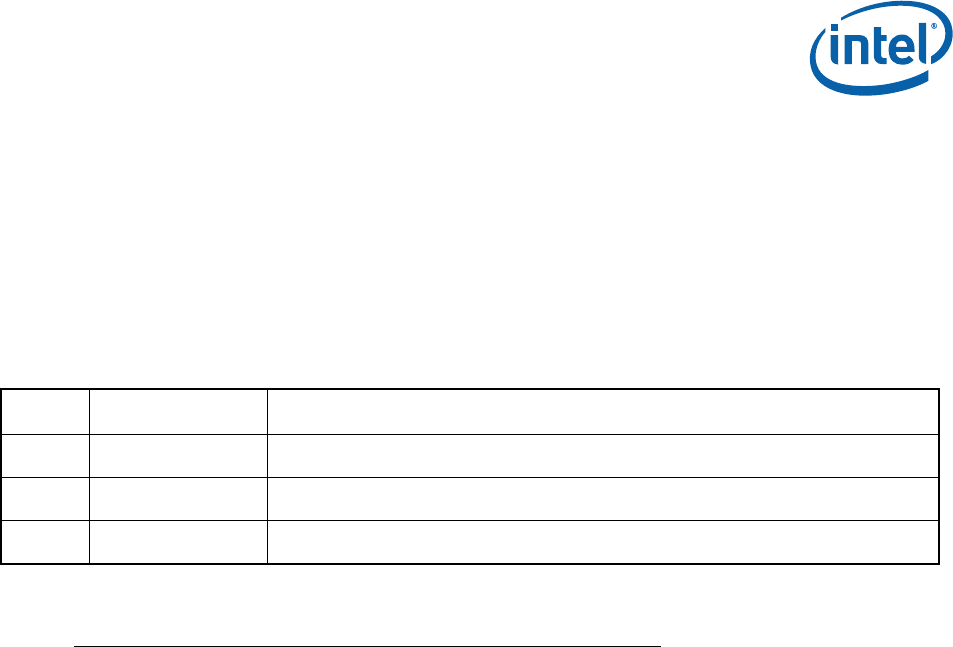
Real Time Instruction Trace
December 2015
Real Time Instruction Trace
Programming Reference v1.05
33
3.3.9 RTIT_PKT_CNT MSR
RTIT_PKT_CNT holds the number of packet bytes that have been generated since either RTIT was
initially enabled, or a PSB packet was last sent out. It does not count packets that were dropped due
to buffer overflow, since they were not ‘generated’. The Pkt_Cnt should also count the bytes in the
PSB packet itself.
The MSR address is: 0x77C. Reset Value: 0x00020000.
Table 11: RTIT Packet Bytes Counter
Bit Name Description
[13:0] Pkt_Cnt ContainsthenumberofbytesofRTITpacketsgeneratedsincelastPSB
[15:14] Reserved Reserved
[17:16] Pkt_Mask IndicateswhatvalueofPkt_CntshouldcauseaPSBtobesentout
The Pkt_Mask field indicates when a PSB packet will be sent (which will also clear the Pkt_Cnt field).
Pkt_Mask value PSB sent out when this Pkt_Cnt bit is set
0 11 (size of roughly 2047 bytes)
1 12 (size of roughly 4095 bytes)
2 13 (size of roughly 8191 bytes)
3 14 (size of roughly 16383 bytes) <= Note that bit 14 does not
exist in this field; so consider it overflow of this field.
So when the Pkt_Mask value is 0, then the PSB is sent out (and the Pkt_Cnt field is cleared) whenever
the Pkt_Cnt value has a value with bit 11 set.
Usually, this would occur due to a packet being generated and causing the Pkt_Cnt to be incremented
to a value that has the ‘monitored bit’ set. So unless an MSR write is used to change Pkt_Cnt, a
Pkt_Mask of 2 will mean that a PSB packet is generated approximately every 8095 (2
13
-1) packet
bytes generated. The Pkt_Cnt will also be reset to 0.
This is evaluated on writes to this MSR and after every packet is generated. Thus the PSB will not be
generated in the middle of a packet, but may be generated between the packets generated by a single
instruction.
For example: Pkt_Cnt value is 0xffc and PKT_Mask is 1 and a far transfer then occurs. It generates a
FUP.FAR packet of 7 bytes (no compression was possible) and a FUP.TIP packet of 5 bytes (zero
compression). The hardware detects the FUP.FAR would increase the Pkt_Cnt to a value with bit 12 set
(the monitored bit). As a result, it changes the Pkt_Cnt to 0 (not 3, which is what would happen if we
simply cleared bit 12 of the output). Then a PSB packet is generated (which is 9 bytes in size), and
the Pkt_Cnt is incremented to a value of 9. Then the FUP.TIP is sent out and the Pkt_Cnt is
incremented by 5 to a value of 0xE. The end result is the packets sent out are FUP.FAR, PSB, FUP.TIP
and the Pkt_Cnt goes from 0xffc to 0xE.
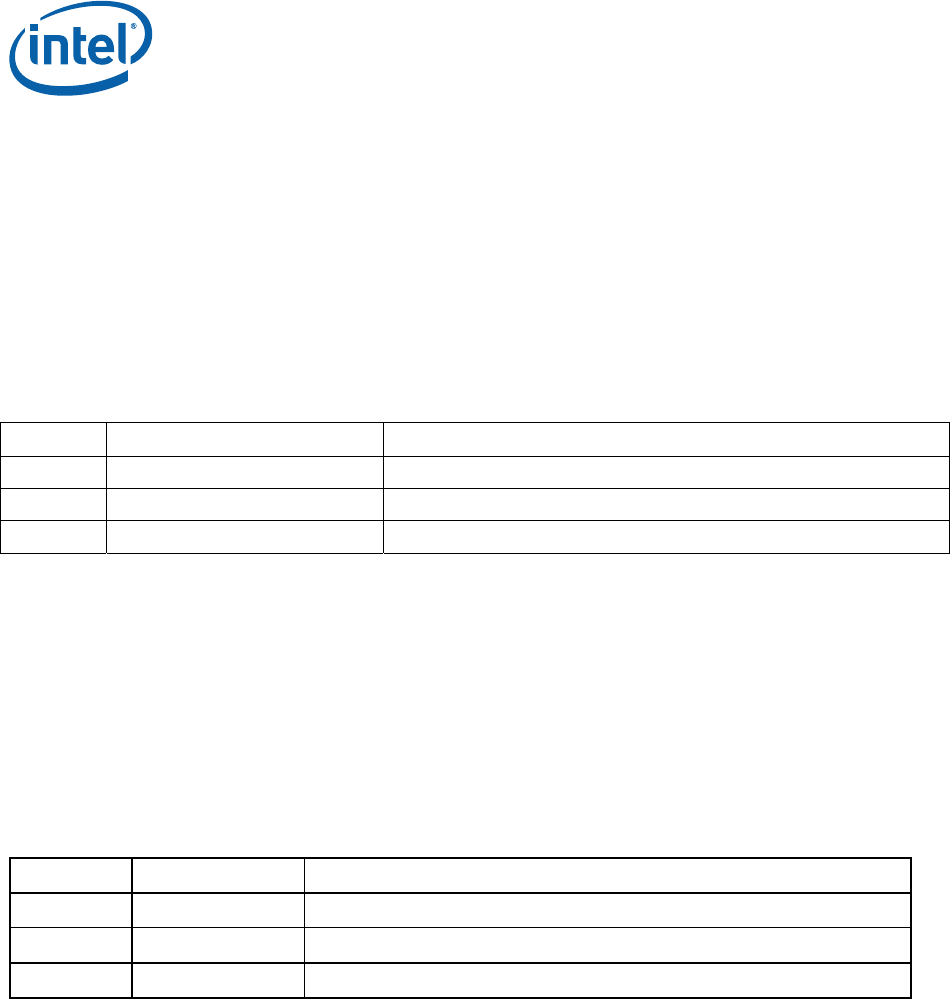
Real Time Instruction Trace
Real Time Instruction Trace
Programming Reference v1.05
December 2015
34
The PSB packet clears out the last LIP and last CALL NLIP compression; however, this does not take
effect until the packet that caused the Pkt_Cnt overflow is drained from the internal RTIT buffer into
memory unit buffers. This means that some number of packets in the trace after the PSB packet may
not have the last LIP and last CALL NLIP compression. On Intel
®
Atom™ processors, the LAST_LIP and
LAST_CALL_NLIP compression are guaranteed to be cleared no more than 4 packets after the PSB
packet.
3.3.10 RTIT_BASE_ADDR MSR
The MSR address is: 0x770. Reset Value: 0xFDC00000.
Table 12: RTIT Output Base Address
Bit Name Description
[5:0] Reserved Reserved as 0
[35:6] Base_Phys_Addr The physical base address for the RTIT output
[63:36] Reserved Reserved as 0
RTIT_BASE_ADDR holds the physical base address where the RTIT packets will be written. The
hardware uses RTIT_BASE_ADDR & RTIT_LIMIT_MASK as the output base address. This means that
any bit which is set in both the base and mask MSR will be treated as if it was 0 in the base for all
address calculations. For this reason, it is recommended to ensure that the RTIT_BASE_ADDR value is
aligned to the size of the region (RTIT_LIMIT_MASK+1).
3.3.11 RTIT_LIMIT_MASK MSR
The MSR address is: 0x771. Reset Value: 0x7F.
Table 13: RTIT Output Limit Mask
Bit Name Description
[5:0] Rsvd_as_1 Reserved as 3F
[21:6] Mask_Value Mask value ANDed with RTIT write pointer offset
[31:22] Reserved Reserved
The CPU will AND this value to the RTIT base offset to figure out when the RTIT base offset pointer
need to wrap back to 0. Since this field is defined up to bit 21, an RTIT output buffer of up to 4 MB in
size (2
22
) can be supported.
The hardware uses RTIT_BASE_ADDR & RTIT_LIMIT_MASK as the output base address. This means
that any bit which is set in both the base and mask MSR will be treated as if it was 0 in the base for all
address calculations. For this reason, it is recommended to ensure that the RTIT_BASE_ADDR value is
aligned to the size of the region (RTIT_LIMIT_MASK+1).
3.3.12 RTIT_OFFSET MSR
The MSR address is: 0x772. Reset Value: 32’bh000.
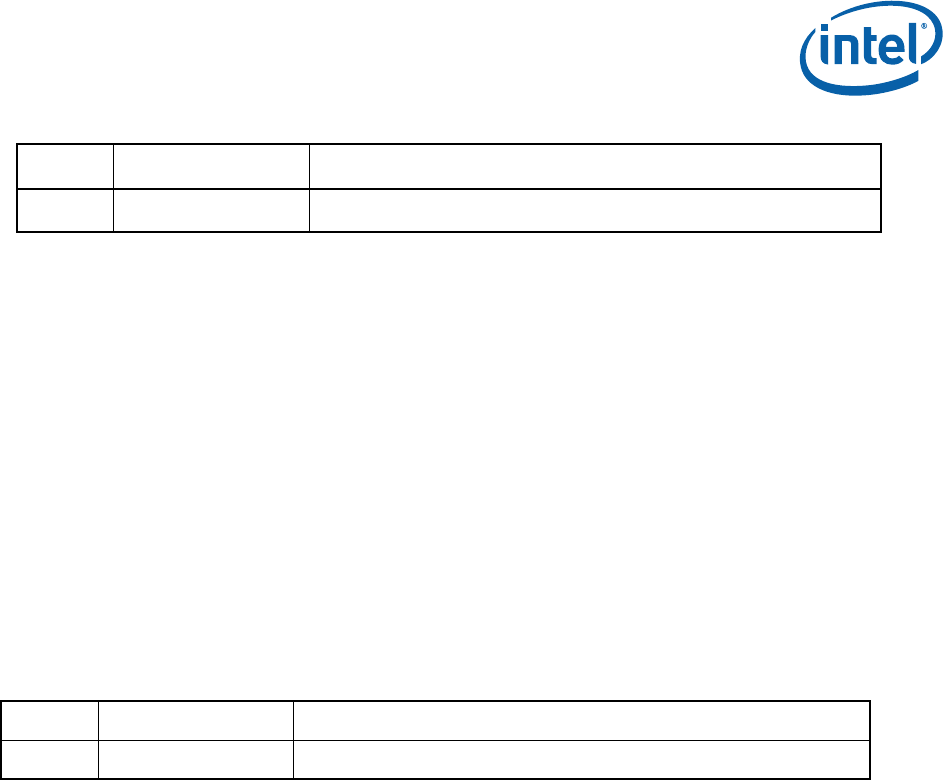
Real Time Instruction Trace
December 2015
Real Time Instruction Trace
Programming Reference v1.05
35
Table 14: RTIT Output Offset
Bit Name Description
[21:0] Offset Holds the value added to base to determine write address
This MSR holds the offset within the current RTIT buffer. Adding it to the RTIT base will tell which
physical address the next RTIT output byte should be sent to.
Since the value in this MSR will change as bytes drain from internal RTIT buffers, it can change even
when no packets are being generated. To ensure that it is ‘settled’ an RTIT-draining operation should
be done (like a WRMSR to RTIT_CTL) between the last thing can generate a packet and an accesses to
this MSR.
3.3.13 RTIT_TNT_BUFF MSR
The TNT_BUFF MSR should be initialized by writing a value of 1 instead of 0. Software should not
attempt to write all zeroes to this MSR, as the hardware may not function correctly and may not
generate the correct packets. A MSR write that attempts to write a value of all zeroes will cause a
#GP.
The MSR address is 0x77D. This register is reset to a value of 1’b1.
Table 15: RTIT TNT Packet Buffer
Bit Name Description
[6:0] TNT Corresponds to TNT packet byte0.
All bits to the right of the MSB are valid when the MSB is set (1) (just like the actual TNT packet.)
RTIT_TNT_BUFF is a R/W MSR used to accumulate TNT packet bits as they are generated. Capturing
the TNT bits for the next TNT packet in this MSR allows the processor to save and restore them in C6
events. There is also an MSR to allow software to change the value of this MSR on context switches.
As TNT bits shift in from the right, the valid bit (the first leading ‘1’ i.e. MSB) is also left shifted. Once
the valid bit (MSB/leading’1’) is in bit position 6, a full TNT packet exists (and it should be soon sent
out).
Once the full TNT packet is generated, the lower byte is sent out as a TNT packet (with cycle count
added after it if Cycle Accurate mode is enabled), and this MSR is reset back to ‘1’. For more
information on TNT packet generation and byte contents, please refer to the TNT packet description.
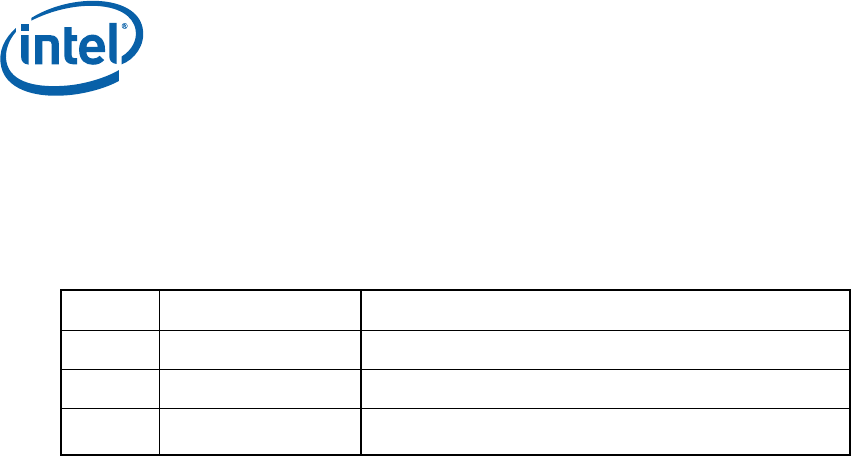
Real Time Instruction Trace
Real Time Instruction Trace
Programming Reference v1.05
December 2015
36
3.3.14 RTIT_LAST_CALL_NLIP MSR
MSR write will cause a #GP on any attempt to set a reserved bit.
The MSR address is 0x76F. Reset Value: 32’bh000.
Table 16: RTIT Last Call NLIP
Bit Name Description
[31:0] Call_NLIP[31:0] Stores the NLIP[31:0] of the last Call Instruction
[47:32] Call_NLIP[47:32] Stores the NLIP [47:32] of the last Call Instruction
48 NLIP_Valid The stored NLIP[47:0] is valid
The RTIT_LAST_CALL_NLIP registers are used to store the NLIP of the last call retired. This is used
for compressing the packet generation of indirect call/returns. For more details on the underlying
architecture and a description of return compression please refer to the indirect transfer compression
for returns section: “Indirect Transfer compression for returns (RET)”.
This entire MSR is cleared to 0 (reset value) when a PSB packet is generated and when a buffer
overflow packet is generated.
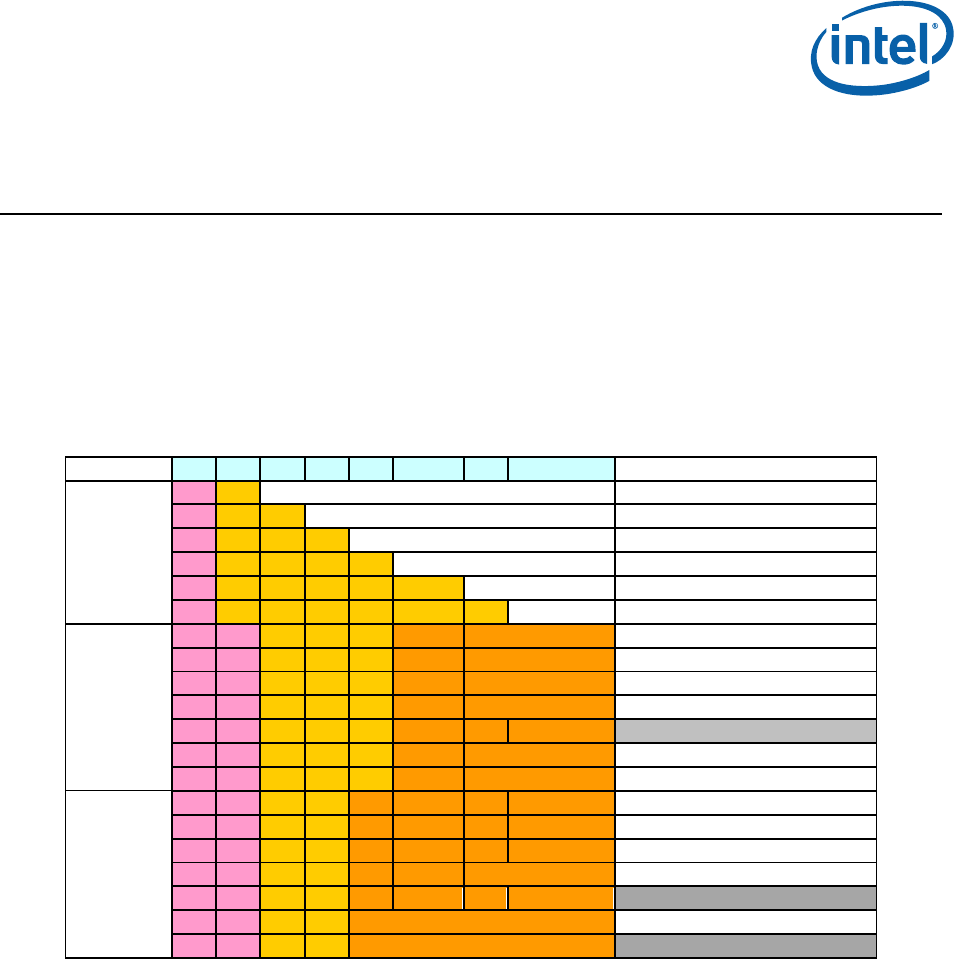
Real Time Instruction Trace
December 2015
Real Time Instruction Trace
Programming Reference v1.05
37
4 Trace Packets and Data Types
This chapter details the data generated by RTIT. It is useful for developers writing the interpretation
code that will decode the data from RTIT and apply it to the traced source code. This chapter can also
be used as a reference for the data structures and formats generated by RTIT.
4.1 Trace Packet Summary
The following summarize the trace packet header.
7 6 5 4 3 2 1 0
TNT
0 1 TNT 6 TNT
0 0 1 TNT 5 TNT
0 0 0 1 TNT 4 TNT
0 0 0 0 1 TNT 3 TNT
0 0 0 0 0 1 TNT 2 TNT
0 0 0 0 0 0 1 TNT 1 TNT
FUP
1 0 0 0 0 Zext CNT PKT Gen Enable
1 0 0 0 1 Zext CNT PKT Gen Disable
1 0 0 1 0 Zext CNT Buffer Overflow
1 0 0 1 1 Zext CNT Periodic Cycle Count
1 0 1 0 x X x x Reserved
1 0 1 1 0 Zext CNT Target IP
1 0 1 1 1 Zext CNT Far Transfer
Extended
1 1 0 0 0 0 0 0 PSB
1 1 0 0 0 0 0 1 TraceSTOP (stop trigger)
1 1 0 0 0 0 1 CR0.PG Paging Information
1 1 0 0 0 1 RNG MTC
1 1 0 0 1 X x x Reserved
1 1 0 1 ACBR[5:2] Super Time Synch
1 1 1 X X Reserved
Figure 2: RTIT Packet Header List
The table below indicates in what modes certain packets are sent out. It is a summary table and
should match the information documented in each of the specific packet sections.
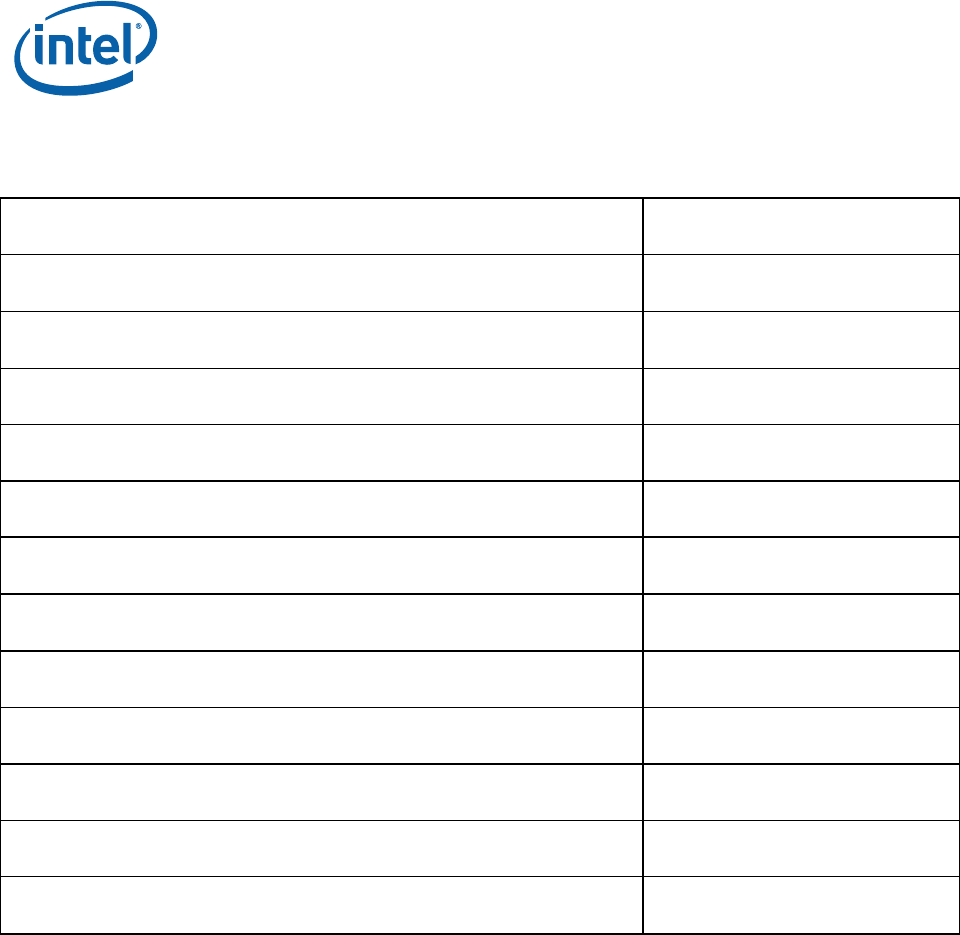
Real Time Instruction Trace
Real Time Instruction Trace
Programming Reference v1.05
December 2015
38
Table 17: Trace Packet Enabling Summary
Packet When enabled
“Branch packets” - TNT, TIP, FUP.Far Transfer, TriggerEn && ContextEn &&
FilterEn
FUP.PacketGenEn TriggerEn && ContextEn &&
FilterEn
FUP.PacketGenDis TriggerEn
TraceStop Clearing of TriggerEn
Packet Stream Buffer TriggerEn
Super Time Synch and Mini-Time Counter with
RTIT_CTL[LESS_PKTS] set
TriggerEn && ContextEn &&
FilterEn
Super Time Synch and Mini-Time Counter with
RTIT_CTL[LESS_PKTS] clear
TriggerEn
FUP.PCC with RTIT_CTL[LESS_PKTS] set TriggerEn && ContextEn &&
FilterEn
FUP.PCC with RTIT_CTL[LESS_PKTS] clear TriggerEn && ContextEn
FUP.Buffer Overflow TriggerEn && ContextEn
Cycle Counter incrementing with RTIT_CTL[LESS_PKTS] set TriggerEn && ContextEn
Cycle Counter incrementing with RTIT_CTL[LESS_PKTS] clear TriggerEn && ContextEn &&
FilterEn
4.2 Packet Types
4.2.1 Packet Stream Boundary (PSB)
A PSB packet is for trace simulation software to identify a trace stream boundary. The trace packet
output port size is not aligned to a trace packet word width, and the packets are written circularly into
the external debugger trace buffer; it cannot be determined whether the data stream carries a valid
trace packet, or just junk data.
A PSB packet consists of header 8’b1100_0000, and 8 contiguous bytes of 0, clearly indicating the
packet stream boundary.
The bytes of zeroes in PSB should be more than the largest possible trace packet payload that might
contain zeroes. So far, the injected packet can have up to 7 bytes of 0s, hence we put the PSB
payload to be 8 bytes.
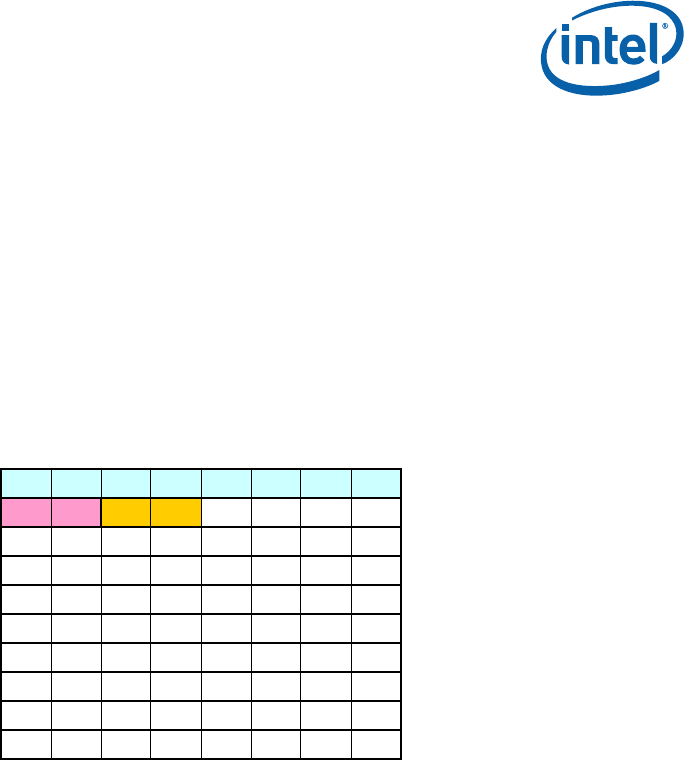
Real Time Instruction Trace
December 2015
Real Time Instruction Trace
Programming Reference v1.05
39
A PSB will be generated when either of the following occurs:
Trigger Enable (RTIT_STATUS[TriggerEn]) goes from 0 to 1
o This will only happen on an MSR write (e.g. WRMSR or VMX MSR load table) to
RTIT_CTL that sets RTIT_CTL[TraceActive] and RTIT_CTL[Trace_En].
RTIT_PKT_CNT[Pkt_Mask] indicates that a PSB packet should be sent out
o E.g., it can be configured to send out packets every 8K packet bytes.
o See MSR definition for RTIT_PKT_CNT for more details
PSB packets may be generated in other cases as well. The trace decoder should be tolerant of extra
PSBs.
7 6 5 4 3 2 1 0
1 1 0 0 0 0 0 0
0 0 0 0 0 0 0 0
0 0 0 0 0 0 0 0
0 0 0 0 0 0 0 0
0 0 0 0 0 0 0 0
0 0 0 0 0 0 0 0
0 0 0 0 0 0 0 0
0 0 0 0 0 0 0 0
0 0 0 0 0 0 0 0
Figure 3: Packet Stream Boundary
When the PSB is generated from value indicated by Pkt_Mask field, both RET and Last LIP
compression MSRs have their valid bits cleared.
The PSB packet can be sent out when TriggerEn is set.
More than one PSB may be generated at stream boundaries.
4.2.2 TNT Packet
TNT packet contains the instruction flow information for conditional direct jumps (Jcc and LOOP) and
RETs whose target matches the last NLIP.
Embedded in the packet header are the T/NT fields:
T indicates that the transfer is taken. This is indicated by ‘1.
NT indicates that the transfer is not taken (fall through). This is indicated by ‘0.
Up to 6 T/NT fields can be packed in a single TNT packet.
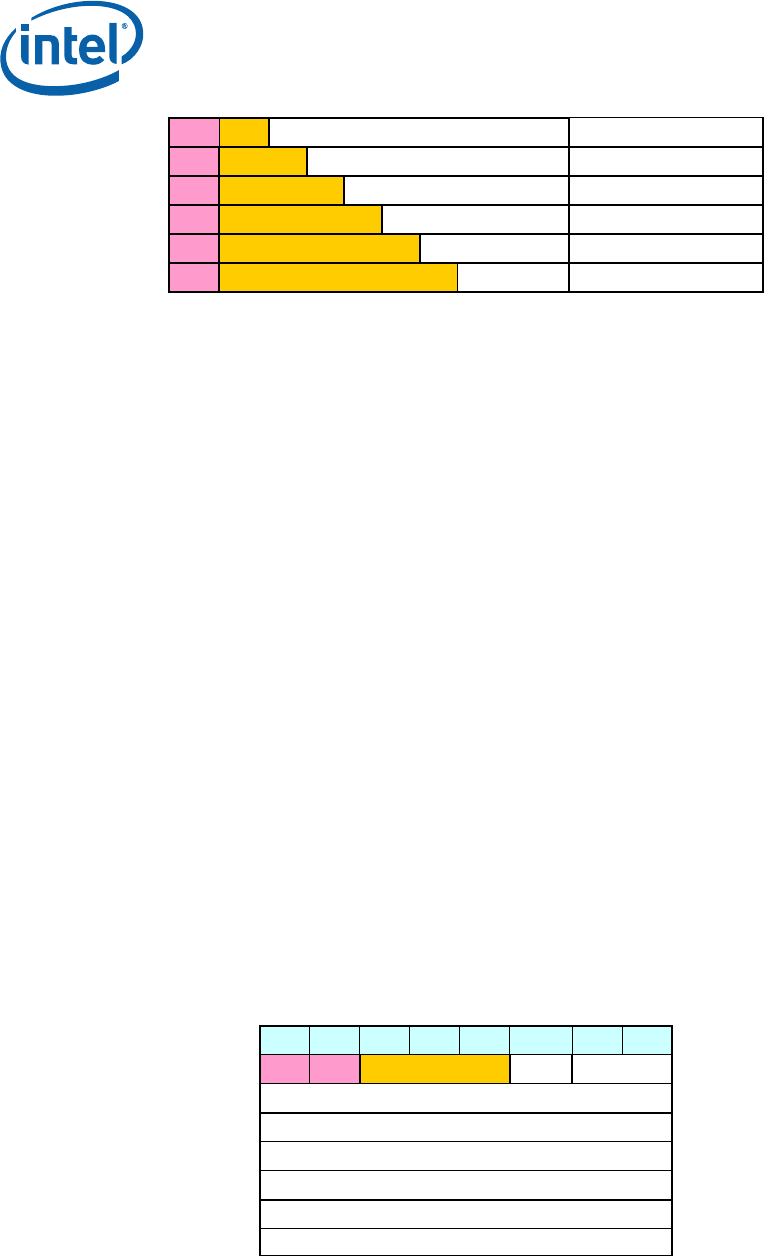
Real Time Instruction Trace
Real Time Instruction Trace
Programming Reference v1.05
December 2015
40
0 1 TNT 6 TNT
0 0 1 TNT 5 TNT
0 0 0 1 TNT 4 TNT
0 0 0 0 1 TNT 3 TNT
0 0 0 0 0 1 TNT 2 TNT
0 0 0 0 0 0 1 TNT 1 TNT
Figure 4: Taken Not Taken Packet
TNT packets are sent whenever 6 direct transfers are collected, or if any other packet needs to be
sent. For example, we could have 4 direct branches followed by an indirect, which would trigger a TNT
packet with the 4 branches, followed by the Target IP packet with the indirect target.
The following cases will cause a partial TNT to be sent:
Flow Update Packet
Target IP Packet
Paging Information Packet
A case that will cause many packets is that we are building a TNT Packet, and then execute a far
transfer (e.g. an interrupt). Under this circumstance, we first send a partial TNT Packet, then a Flow
Update Packet and finally a Target IP Packet.
Note that a full TNT packet that causes a buffer overflow may be delayed instead of being dropped
and could be sent out before the buffer overflow packet is sent out. In this case, the cycle time of the
TNT packet will reflect when the buffer overflow packet was generated and not when the 6
th
jump was
recorded into the TNT packet. More details on this scenario, including how to detect it, are
documented in the buffer overflow packet section.
Also note that the TNT buffer is not drained on a TraceStop action. To properly understand what
occurred at the very end of the trace, the RTIT analyzer may need to manually read out the contents
of RTIT_TNT_BUFF MSR (e.g. with RDMSR).
4.2.3 Target IP Packet
For every indirect jump and procedure call, exception/interrupt, and interrupt return, a Target IP
Packet containing destination address is generated.
7 6 5 4 3 2 1 0
1 0 1 1 0 Zext
CNT
BLIP
BLIP
BLIP
BLIP
BLIP
BLIP
Figure 5: Target IP Packet

Real Time Instruction Trace
December 2015
Real Time Instruction Trace
Programming Reference v1.05
41
Target IP Packet contains 2B, 4B, or 6B BLIP payload, depending on the compression. CNT indicating
BLIP size in the number of bytes:
2’00: 2 bytes of BLIP - this is the minimum size of BLIP
2’01: 4 bytes of BLIP
2’10: 6 bytes of BLIP - no compression is applied
2’11: reserved
Zext is used to indicate whether the BLIP payload is compressed with zero extension or comparison
with LIP sent out previously, as discussed below.
4.2.3.1 LIP Compression
There are two ways to compress a LIP: by noting it did not change much from the last LIP sent out, or
by noting that the upper bytes are zeroes.
The LIP is compared with the LIP that was saved into the RTIT_LAST_LIP MSR, which holds the LIP of
whatever was sent out in the last LIP-containing packet (Target IP or Flow Update). RTIT_LAST_LIP is
updated with the full LIP, even if that packet did not send out that full LIP due to it also being
compressed. If the previous packet that sent out a LIP had the same bytes in the MSB bytes (upper
part) of the address, then we can avoid sending them again in the current packet.
The LIP is also checked to see whether MSB bytes consist solely of zeroes. If so, we only send the
non-zero bytes of LIP; and we set the Zext bit to indicate that the higher bytes are zeroes.
The lowered count field implies that the upper bits are either the same as the previous LIP, or zero
(depending on Zext bit).
The matching and zero checking are for two groups: higher 2 bytes of BLIP (BLIP5/4), and middle 2
bytes of BLIP (BLIP3/2). The following table summarizes CNT and Zext based on the bits:
Table 18: LIP Compression
CNT in packet Zext in
packet
Match
of 47:32
Match
of 31:16
LIP[47:32]
is all 0s
LIP[31:16]
is all 0s
CNT = 0 (2 byte LIP) Zext = 0 1 1 0 X
CNT = 0 (2 byte LIP) Zext = 0 1 1 1 0
CNT = 0 (2 byte LIP) Zext = 1 X X 1 1
CNT = 1 (4 byte LIP) Zext = 0 1 0 0 X
CNT = 1 (4 byte LIP) Zext = 1 X 0 1 0
CNT = 1 (4 byte LIP) Zext = 1 0 X 1 0
CNT = 2 (6 byte LIP) Zext = 0 0 X 0 X

Real Time Instruction Trace
Real Time Instruction Trace
Programming Reference v1.05
December 2015
42
“Match of 47:32” being 1 means that bits 47:32 of the LIP that this packet wants to send out are
equal to RTIT_LAST_LIP[CMPRS_LIP_HIGH] (which usually holds LIP[47:32] of the LIP that was sent
out in the last packet that had a LIP—even if that previous packet was also compressed (and thus
didn’t send out those bytes)).
An X means that the table row applies regardless of whether it was 0 or 1. Note that zero extension is
a preferred compression mechanism over LIP match, as it is easier for software to reconstruct LIP.
The compressed LIP is only updated when RTIT is not generating a buffer overflow packet. It is also
cleared on each PSB generated.
LIP compression occurs prior to storing the trace message in the RITT Buffer. The following are
possible LIP insertion/compression scenarios:
1.
If the LIP being inserted into the buffer is the first LIP to be inserted, then it can't be
compressed, as there is nothing to compress against. However, the Last LIP compare register
should be updated with the current LIP, in this case to prepare for subsequent compression.
2.
If the LIP being inserted into the buffer is not the first LIP to be inserted, then the LIP being
inserted is compressed against the contents of the Last LIP compare register, and Last LIP
compare takes on the new value of the LIP currently being inserted.
3.
In the event two RTIT packets are to be inserted back to back, then LIP0 is compressed
against Last LIP register (or bypass), then LIP1 compressed against LIP0, and LIP1 updates
the Last LIP compare MSR.
4.
In the event three RTIT packets are to be inserted back to back (three LIP generating events
occurred in a single retirement window), LIP0 compresses against Last LIP MSR (or bypass),
then LIP1 compresses against LIP0, and then LIP2 compressed against LIP1 and LIP2 updates
the Last LIP MSR.
4.2.3.2 Indirect Transfer compression for returns (RET)
In addition to LIP compression, RTIT has the ability to further compress indirect transfer packets for
call/return pairs if enabled (RTIT_CTL.CMPRS_RET is set). A ‘pair’ is defined as a near CALL
instruction (direct or indirect) followed by a near RET instruction that returns execution to the
instruction following that previous call.
This current architecture does not support compressing the indirect transfer packet if the near RET
does not return to the exact same address as the NLIP of the last near CALL that was traced (as held
in RTIT_LAST_CALL_NLIP MSR). Thus only the innermost CALL/RET pairs of nested subroutines will
have their compression on their RET.
Likewise, if the software does not RET to the NLIP of the last CALL (e.g., the return address on the
stack was modified), then the RET’s packet will not be compressed through indirect transfer
compression.
If return compression is enabled, when a call is executed with PacketEn set, the NLIP of the call (the
return address) is not only pushed on the stack, but RTIT stores a copy in RTIT_LAST_CALL_NLIP and
sets the NLIPVal bit. If the subsequent return instruction target address matches the address in
RTIT_LAST_CALL_NLIP (and NLIPVal is set), then a Taken indication is added to the TNT history (if
this TNT update completes the six entries needed for a full TNT packet, then a full TNT packet will be
generated). If the return address does not match RTIT_LAST_CALL_NLIP (e.g., due to nested calls, or
the return address was changed on the stack), then the return will generate a Target IP packet (just
like when RET compression is disabled).

Real Time Instruction Trace
December 2015
Real Time Instruction Trace
Programming Reference v1.05
43
A RET instruction whose RTIT output is compressed (it only updates TNT buffer instead of sending out
a TIP) will not update RTIT_LAST_LIP MSR. Architecturally, it would be fine either way, but this is the
current plan.
Only near call instructions that start with PacketEn set will modify RTIT_LAST_CALL_NLIP. So near
call which is within the filtered region and has PacketEn of 1 but jumps outside the filter region will
still modify RTIT_LAST_CALL_NLIP with its NLIP.
A call instruction that does not start with PacketEn set and RTIT_CTL[CMPRS_RET] set will not write
its NLIP into RTIT_LAST_CALL_NLIP. So a call whose CLIP is outside the filter enable region (and thus
packet_en is 0) will not modify RTIT_LAST_CALL_NLIP, even if the call’s target or NLIP is within the
filter enable region.
Far calls will also not modify RTIT_LAST_CALL_NLIP.
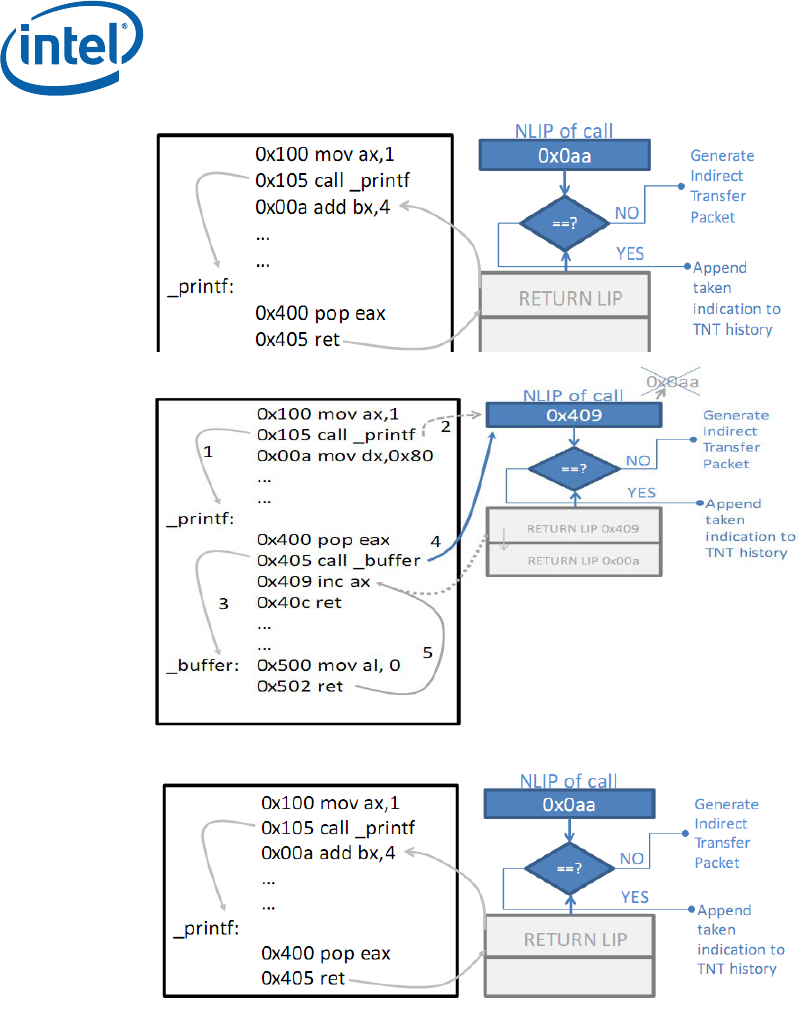
Real Time Instruction Trace
Real Time Instruction Trace
Programming Reference v1.05
December 2015
44
Figure 6: Return compression without nested calls
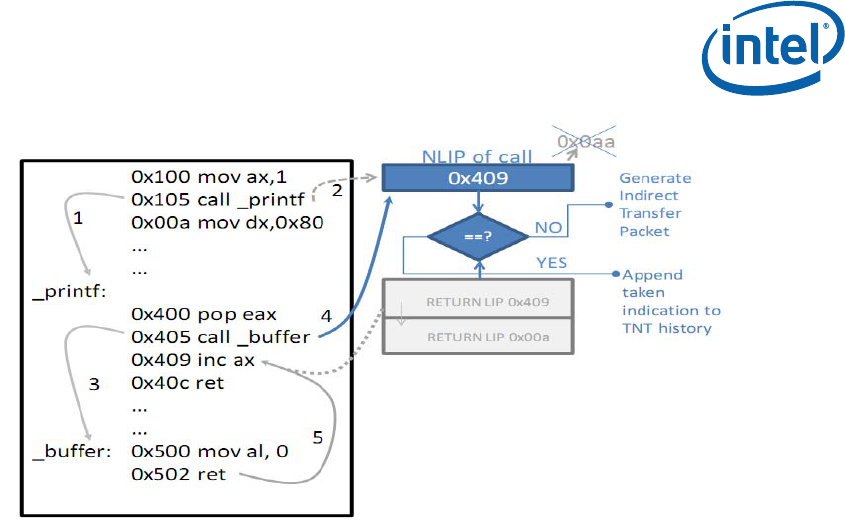
Real Time Instruction Trace
December 2015
Real Time Instruction Trace
Programming Reference v1.05
45
Figure 7: Return compression with nested calls
In the example above, the behavior differs once the second call is encountered (without a RET in
between the two calls). Once the call at address 0x405 is encountered, the call’s NLIP is pushed onto
the stack and copied into the RTIT_LAST_CALL_NLIP register, overwriting the previous call’s NLIP
(steps 3 and 4). After the call at address 0x405 is retired (step 3), code flow is redirected to the
target of the call (_buffer). Code flow continues in this routine until the RET at address 0x502 is
encountered. The RET pulls its return address off the stack, and RTIT compares the return address to
the address stored in RTIT_LAST_CALL_NLIP. For this RET at address 0x502 (step 5), the return
address and the address in RTIT_LAST_CALL_NLIP matches and a Taken indication is stored in the
TNT history. The INC AX instruction at address 0x409 is executed next, then the RET at address
0x40c. For this ret, the return address is again pulled off the stack and compared with address in
RTIT_LAST_CALL_NLIP; in this case there is no match, as RTIT_LAST_CALL_NLIP contains the NLIP of
the previous call (address 0x405) and not the address on the stack (address 0x00a). Since the return
address does not match the RTIT_LAST_CALL_NLIP address, the TNT history is not updated, and RTIT
generates an indirect transfer packet.
RTIT_LAST_CALL_NLIP enable bit is cleared on each PSB generated and is also cleared on buffer
overflow (just in case the buffer overflow prevented some of the info needed for the analyzer to know
the last CALL).
4.2.4 Flow Update Packet
Flow Update Packet is generated for certain situations, as identified by the Event field of the packet:
Event 3’b000: the real time trace package generation is enabled.
Event 3’b001: the real time trace package generation is disabled.
Event 3’b010: the trace architecture just recovered from the buffer overflow.
Event 3’b011: periodic cycle count.
Event 3’b110: This encoding indicates that it is not a FUP. It is actually a Target IP Packet,
as described in the section above.
Event 3’b111: far transfer events: exceptions, traps, interrupts, far jumps.
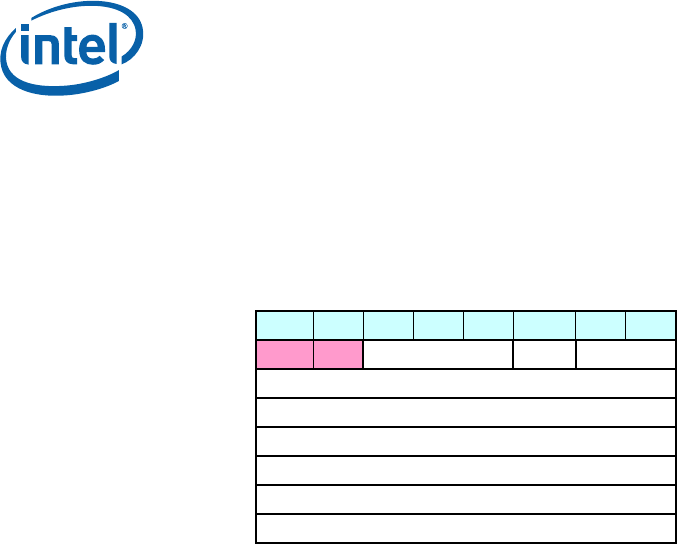
Real Time Instruction Trace
Real Time Instruction Trace
Programming Reference v1.05
December 2015
46
As described in Section 2.2, the NLIP bus sends the CLIP for exceptions and NLIP for other far transfer
events. NLIP0 is sent on the payload for all other Flow Update Packets. Up to 48 bits or 6 bytes of LIP
is sent for debug software to figure out the current program flow location. The number of bytes of LIP
field is indicated by the CNT field of the packet.
The same compression and zero extension as the Target IP Packet is applied to the Flow Update
Packet.
7 6 5 4 3 2 1 0
1 0 Event Zext
CNT
LIP
LIP
LIP
LIP
LIP
LIP
Figure 8: Flow Update Packet
4.2.5 Flow Update event: Buffer Overflow
When new packets need to be generated but the CPU’s internal RTIT buffers are all full, a RTIT “buffer
overflow” occurs. When this occurs, the Buffer_Overflow bit in RTIT_STATUS MSR will be set. When
RTIT_STATUS[Buffer_Overflow] is set, the following things occur:
a) No packets will be generated (as they would need to enter the CPU’s internal RTIT
buffer)
1. Ideally, this means that RTIT_LAST_LIP MSR and RTIT_LAST_CALL_NLIP will
not be modified (since they are only modified when packets are generated).
However, this is not critical, since these MSRs are cleared when the Buffer
Overflow clears out.
2. This means that Pkt_Cnt will not increment (since only incremented when
packets are generated).
b) No conditional branches will update the partial TNT information (RTIT_TNT_BUFF
MSR).
c) The cycle counter will increment, but will not generate PCC packets (see below).
The address comparisons to RANGE0 or RANGE1 continue during a buffer overflow and TriggerEn,
ContextEn, and FilterEn may change during a buffer overflow. Any FUP.PGE or FUP.PGD packets that
would have been generated will be dropped/lost.
The cycle counter does not stop incrementing due to a buffer overflow. However, the periodic cycle
counter packet will not be dropped due to a buffer overflow. Instead, the periodic cycle counter
(FUP.PCC) will not be generated (and thus the cycle counter will not be auto-reset) until after the
buffer overflow has cleared out (and after the buffer overflow packet has been sent). If the buffer
overflow packet contains a cycle count that can cause the cycle counter to be reset without any
FUP.PCC being needed. A buffer overflow should never last long enough to cause the cycle counter to
overflow. Any mini time counter (MTC) packets that need to be sent during a buffer overflow will be
dropped. If only a few MTC packets are dropped, the RTIT analyzer should be able to detect this by
noticing that the time value in the first MTC packet after the buffer overflow incremented by more
than one. If the buffer overflow lasted so long that that >255 MTC packets are lost (and thus the MTC

Real Time Instruction Trace
December 2015
Real Time Instruction Trace
Programming Reference v1.05
47
packet ‘wraps’ its 8-bit TSC value), then the RTIT analyzer may be unable to properly understand the
trace. If this is suspected, MTC_range should be increased.
The buffer overflow condition will not be cleared until:
a) The RTIT buffer has completely drained to the memory unit and is empty.
b) An instruction is starting while TriggerEn==1 and ContextEn==1 at the beginning of
the instruction.
When the buffer overflow condition is cleared by the above conditions, the buffer overflow has
‘naturally’ cleared (to differentiate from being cleared by an MSR write). When the buffer overflow is
naturally cleared, the Buffer_Overflow bit of RTIT_STATUS is cleared, a FUP.BuffOvf (flow update
packet of type buffer overflow - event field is 010b) is generated, and the valid bits of the
RTIT_LAST_LIP and RTIT_LAST_CALL_NLIP MSRs are cleared. They are cleared before the overflow
packet is sent, so the FUP.BuffOvf will never contain a last LIP compressed address.
The address contained in the FUP.BuffOvf will be the start of the next instruction after the currently
executing instruction (the NLIP of the current instruction). Thus, on clearing of a buffer overflow, the
analyzer will know exactly where the CPU is now executing, but will not know the exact instruction
where the buffer overflow occurred.
If there are taken/not taken indications in RTIT_TNT_BUFF, then they will be sent out before the
FUP.BuffOvf is sent. They will represent taken/not taken branches before the buffer overflow occurred,
and thus can help the analyzer understand what code was executing when the buffer overflow
occurred. This will also occur if the RTIT_TNT_BUFF was completely full with 6 branches and it was the
TNT packet itself that attempted to cause the overflow. In that case, the full TNT packet will not be
dropped and will still be seen in the trace before the buffer overflow packet.
Full TNT packets include cycle count packets; but that in this case, the TNT packet cycle count will be
the time when the buffer overflow was drained and not when the 6
th
branch occurred that filled up the
TNT buffer. When the trace analyzer sees a full TNT packet followed by a buffer overflow and the
buffer overflow packet has a cycle count of 0 that means this situation has occurred. In this case, the
trace analyzer should not treat the cycle count at the end of the full TNT packet as the time when the
6
th
jump retired; instead, it is the time when the buffer overflow packet was sent.
If a TraceStop action occurred during the buffer overflow (which means that the IP matched that
specified in RANGE0 or RANGE1 and that range was programmed to cause a TraceStop by
TraceStop_Event_ID), then that TraceStop action will be held pending during the buffer overflow and
will not be dropped. Once the buffer overflow packet has been sent, the TraceStop action will occur—
which includes clearing out RTIT_CTL[Trace_Active], sending out the TraceStop packet, and possibly
draining RTIT buffers again. This means that the buffer overflow packet may contain an address
reached after the filtering logic pended the TraceStop action. It also means that the cycle counter will
continue running after the filtering logic pended the TraceStop action.
The FUP.BuffOvf can cause a PSB packet to be generated due to its incrementing of Pkt_Cnt.
If TriggerEn becomes 0 and then goes back to 1 (due to an MSR write) during a buffer overflow, a PSB
packet will be generated. It is possible for this PSB packet to be seen in the trace before the buffer
overflow packet, even though the re-setting of TriggerEn occurs after the buffer overflow started.
Additionally, if a TraceStop packet was pending when TriggerEn became 0, the PSB packet may come
out before the TraceStop packet.
Although the packet ordering does not match the order in which the actions occurred, this is not
expected to be a real problem for the RTIT analyzer, since the purpose of the PSB packet is still met
(which is to ensure that the header bytes can be found in the trace).

Real Time Instruction Trace
Real Time Instruction Trace
Programming Reference v1.05
December 2015
48
The Buffer_Overflow can also be changed by software writing RTIT_STATUS MSR. Clearing the bit
through an MSR write is not a ‘natural’ clearing and it will not cause a buffer overflow packet to be
generated. If the Buffer_Overflow bit is set through an MSR write to RTIT_STATUS that must have the
same effect as if a packet was generated when the buffer was full (e.g. preventing further packets
from getting into the internal buffer while Buffer_Overflow bit is set).
If an RTIT drain occurs (e.g. as part of a WRMSR to RTIT_CTL) while Buffer_Overflow is set, the drain
will complete without Buffer_Overflow being cleared. This is because Buffer_Overflow only clears
naturally (meaning not through MSR write) at instruction boundaries. Thus it is possible for a drain to
complete without forcing out the Buffer Overflow packet (FUP.BuffOvf) that is generated by the
natural clearing of RTIT_STATUS[Buffer_Overflow].
4.2.6 Flow Update event: Packet Cycle Counter
This is commonly called “FUP.PCC”. The RTIT hardware will send out a Periodic Cycle Count
(FUP.PCC) Packet at the beginning of an instruction when the MSB (bit 21) of RTIT_CNTP[CNTP] is set,
the cycle count is enabled (RTIT_CTL[CYCLE_ACC]==1), and the processor is in the appropriate
mode.
When LESS_PKTS is set, FUP.PCC packets are only sent out when (TriggerEn && ContextEn &&
FilterEn) == 1.
When LESS_PKTS is clear, FUP.PCC packets are only sent out when (TriggerEn && ContextEn) ==
1.
The address in the FUP.PCC’s LIP field is the NLIP of the instruction (the first byte of the next
sequential instruction). This is the same as the buffer overflow packet. This can lead to an address
being sent out which is never executed (e.g. the instruction sequentially after a RET). The RTIT_CNTP
packet may be delayed if another packet non-PSB needs to be sent out at the same time.
Although it is only sent out at instruction boundaries, it is normally sent out when it is ‘half full’ (its
MSB is set). So there is little chance of the cycle counter overflowing before the FUP.PCC could be sent
out.
Since the Periodic Cycle Count packet is only sent out in cycle accurate mode (assuming an MSR write
isn’t used to set the MSB of CNTP), it will naturally include the cycle count. And thus sending it out will
also clear out the cycle counter (CNTP) – since that happens whenever the cycle count packet is sent.
Sometimes this packet is incorrectly referred to as the “Cycle Count Overflow packet”.
4.2.7 Flow Update event: Packet Generation Enable
This is commonly called “FUP.PGE”. This packet is generated when PacketEn transitions from 0 to 1.
This can happen for a range of reasons including:
a) “Walking into the region” (having FilterEn become set due to the NLIP matching the region
specified by Filter EventID).
b) Jumping into the region (having FilterEn become set due to the branch target being within the
region specified by Filter EventID).
c) Having ContextEnable become 1 and already being in the right range.
a. This could happen due to a WRMSR to an RTIT MSR, a CR3 changing operation, a
change in CPL, a VM-entry, or RSM.
d) Enabling RTIT (TriggerEn from 0 to 1) and being in the right mode and IP range such that
ContextEn and FilterEn also become 1.

Real Time Instruction Trace
December 2015
Real Time Instruction Trace
Programming Reference v1.05
49
The FUP.PGE is actually sent out by the instruction that ‘ends’ in the right mode/range.
The LIP carried in the FUP.PGE packet is the address of the next instruction that should execute
(assuming no trap/interrupt), which will always be an address in the right mode/range.
4.2.8 Flow Update event: Packet Generation Disable
This is commonly called “FUP.PGD.” This packet is generated when PacketEn transitions from 1 to 0,
with an exception mentioned later.
This can happen for a range of reasons including:
a) “Walking out the region” (having FilterEn become 0 due to the NLIP matching the end of the
region specified by Filter EventID).
b) Jumping out the region (having FilterEn become cleared due to the branch target being
outside the region specified by Filter EventID).
c) Having ContextEnable become 0.
a. This could happen due to a WRMSR to an RTIT MSR, a CR3 changing operation, a
change in CPL, a VM-exit or a SMI.
The FUP.PGD is actually sent out by the instruction that ‘ends’ outside of the right mode/range. Thus,
it is generated by an instruction that started with PacketEn set.
The LIP carried in the FUP.PGD packet is the NLIP of the instruction that caused PacketEn to go from 1
to 0. If it was not an instruction that caused PacketEn to be cleared (e.g., it was an interrupt or trap
or VM exit), then it is the address that would be saved into the LBR FROM field, or into the VMCS or
into the SMRAM.
There is one exception where PacketEn goes from 1 to 0 without a FUP.PGD being generated. A
FUP.PGD may not be generated when TriggerEn becomes 0. This TriggerEn clearing could be due to an
MSR write that clears TraceActive or Trace_En or by a TraceStop event that clears TraceActive. This
aspect of the architecture may be changed in future versions of RTIT if it is a problem for software.
This can cause PacketEn to become 0 without the contents of TNT_BUFF being forced out in a partial
TNT. This could lead to a partial TNT on the next FUP.PGE (which is unusual; but allowed). That partial
TNT would specify where RTIT was disabled.
4.2.9 Flow Update event: Far Transfer
This is commonly called “FUP.FAR”. It is sent out on far transfers to explain where the trace was
before the far transfer. This is important for asynchronous transfers like faults and interrupts; but is
sent out on all far transfers to be consistent. See table 2 (Classifying branches/COFI) for details of
which instructions cause a FUP.FAR to be sent out. The address that is contained in the FUP.FAR is
described in Table 1 (Address in various packets).
On a branch that would naturally generate both a FUP.FAR and a FUP.PGD, the FUP.PGD will replace
the FUP.FAR and no FUP.FAR will be sent. This is a form of compression, and is also thought to
simplify the hardware.
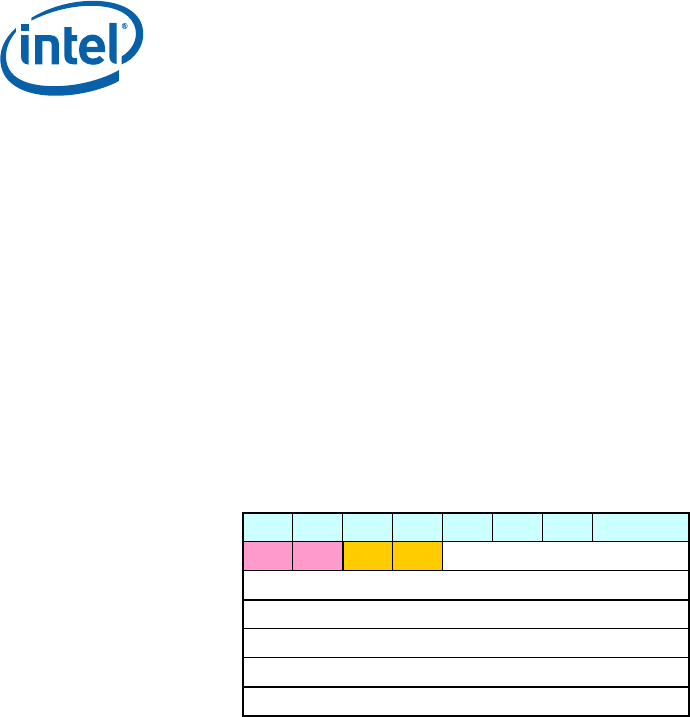
Real Time Instruction Trace
Real Time Instruction Trace
Programming Reference v1.05
December 2015
50
4.2.10 Paging Information Packet (PIP)
This packet will be generated with the new CR3 value and paging enable, on
MOV CR3 operation
MOV CR0 that changes the CR0.PG value
The Paging Information Packet is generated in the above cases when ContextEn and TriggerEn are
both 1 and RTIT_CTL[CR3En] is 0. When RTIT_CTL[Cr3_En] is 1, then software should know what the
CR3 value is whenever ContextEn is 1 and no paging information packet is generated (for simplicity,
this also includes when CR0.PG changes).
The purpose of the PIP is to tell the RTIT analyzer which application is running so that it can
understand which code corresponds to the linear addresses which RTIT is outputting. Some older
versions of Linux* would leave CR3 unchanged and would switch applications by changing PLM4
entries. RTIT will have trouble with such operating systems unless they are modified to log when they
are changing address spaces.
7 6 5 4 3 2 1 0
1 1 0 0 0 0 1 CR0.PG
CR3[7:0]
CR3[15:8]
CR3[23:16]
CR3[31:24]
CR3[39:32]
Figure 9: Paging Information Packet
The new CR3 and CR0.PG values are the ones reported in the packet. There are ways that the CR3 or
CR0.PG can be changed without sending out a paging info packet, like task switches or INIT. A paging
info packet should not be sent out SMIs, RSMs, VM-exits or VM-entry to SMM mode (although SMIs,
VM-exits and VM-entry to SMM will always end with ContextEn==0 anyway).
The RTIT_CTL.STS_on_CR3 bit may cause a STS packet to be sent out (after the Paging Info packet
when Paging Info packets are sent out) if STS packets are sent out in the current mode (depends on
LESS_PKTS; ContextEn evaluated after CR3 value change) on MOV CR3 operations. This can help tell
the analyzer what the current time is, even if there has been no other event that sends out STS
packets for a long time. STS packets might be sent out due to STS_on_CR3 even when Paging Info
packets are not sent out (e.g. because RTIT_CTL[CR3En] is 1).
4.2.11 TraceSTOP Packet
When the IP matches the range specified by the TraceStop EventID while (RTIT_STATUS[ContextEn]
and RTIT_STATUS[TriggerEn] are set), a TraceStop action occurs. This clears RTIT_CTL[TraceActive]
and causes a TraceStop packet to be generated.
The TraceStop action also forces FilterEn to 0.
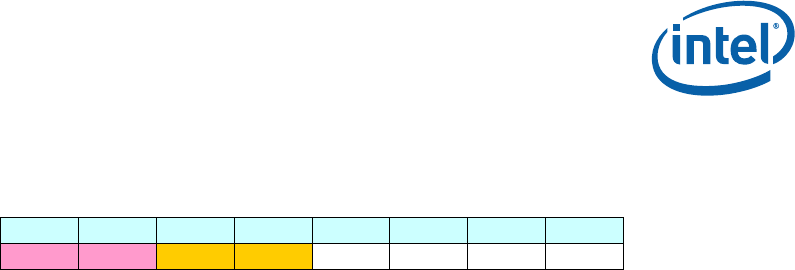
Real Time Instruction Trace
December 2015
Real Time Instruction Trace
Programming Reference v1.05
51
Note that the TNT buffer is not drained on a TraceStop action. To properly understand what occurred
at the very end of the trace, the RTIT analyzer may need to manually read out the contents of
RTIT_TNT_BUFF MSR (e.g. with RDMSR).
7 6 5 4 3 2 1 0
1 1 0 0 0 0 0 1
Figure 10: TraceSTOP Packet
4.2.12 Mini Time Counter (MTC) Packet
The MTC packet, along with the STS packet, helps the analyzer figure out the wall-clock time when
packets were generated. Wall-clock time information can be used to synchronize with other debug
streams (e.g. the RTIT stream from another core, a video recording of the display). MTC, like STS, is
based on the HW TSC that the processor uses to generate IA32_TIMESTAMP_COUNTER (and for
RDTSC).
RTIT can be configured to watch a specified 8-bit range of the HW TSC. Whenever that 8-bit range
being watched changes, an MTC packet will be sent out with the new value of that 8-bit range. This
allows the analyzer to keep track of how much time has elapsed since the last STS packet was sent by
keeping track of how many MTC packets were sent and what their value was.
It is possible for MTC packets to be lost due to buffer overflows. However unless >2^8 MTC packets
are dropped in a row, software will be able to notice that MTC packets were dropped by noticing the
missing packet (e.g. the last time was 0x1a and the new time is 0x1c implies that the packet for 0x1b
was dropped).
MTC packets are enabled by setting RTIT_CTL[MTC_En]. The specific bits are specified by the
RTIT_CTL[MTC_Range] field. A value of ’00 means that HW TSC[14:7] are sent out in the TSC portion
of MTC packets whenever HW TSC [14:7] changes (which is whenever TSC[7] changes). A value of ’01
means that HW TSC [16:9] are sent out in MTC whenever they change. A value of ’10 means that HW
TSC [18:11] are sent out in MTC whenever they change. A value of ’11 means that HW TSC [20:13]
are sent out in MTC whenever they change.
Thus software can either choose to have MTC packets sent out more frequently with finer granularity
of time info (but causes more packet bandwidth and allows wrapping more frequently), or can have
MTC packets sent out less frequently with less granular time info (but less packet bandwidth and less
chance of wrapping in an overflow).
MTC packets are generated whenever TriggerEn is 1 if RTIT_CTL[LESS_PKTS] is clear and whenever
TriggerEn, ContextEn, and FilterEn are all 1 if LESS_PKTS is set.
The RNG field will be the current RTIT_CTL[MTC_Range] value. The MTC will be sent out whenever the
8-bits of the TSC that are to be sent out change. It should be inserted into the buffer immediately
after the TSC changes. The MTC packet may not be sent out when the CPU is in a sleep state.
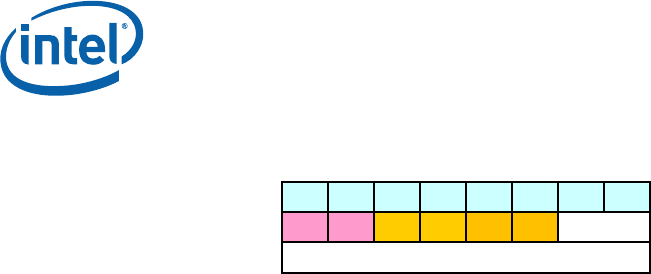
Real Time Instruction Trace
Real Time Instruction Trace
Programming Reference v1.05
December 2015
52
The following is the MTC Packet format.
7 6 5 4 3 2 1 0
1 1 0 0 0 1 RNG
8b TSC (granularity based on count)
Figure 11: Mini Time Counter Packet
Due to per-core offset and VMCS offset, the value in the MTC packet may not be the same value as
read on RDTSC or MSR read of IA32_TIME_STAMP_COUNTER MSR. Software can tell the difference
between the HW TSC (which is sent out by MTC and STS packets) and the
IA32_TIME_STAMP_COUNTER value (also read out by RDTSC) by reading out the per-core offset
through a RDMSR of IA32_TSC_OFFSET. Software techniques may need to be used to discover the
VMCS offset.
4.2.13 Super Time Sync (STS) Packet
This packet will send out both the frequency and current time stamp counter value of the core. This
packet is architecturally sent on:
Core frequency change
Sleep state wakeup (any sleep state, including C1/C2/C4/C6/S0i2)
Clock modulation (e.g., due to TM1 or IA32_CLOCK_MODULATION MSR)
On MOV CR3 operations (when RTIT_CTL. STS_on_CR3 is set)
STS packets may be sent for other cases as well.
The packet includes 5 bytes of “Big time Counter” (which corresponds to the hardware TSC
creg[39:0]). Software can see the difference between the hardware TSC creg and the software TSC
(what is returned on RDTSC) by doing a RDMSR of IA32_TSC_OFFSET MSR (which is introduced on
Silvermont and Haswell). The packet also includes the “Actual Core/Bus ratio” (which is the current
core/bus ratio), and the “Effective Core/Bus ratio” (which is the core/bus ratio that software effectively
operates at when clock modulation is factored in).
Since the big time counter value contains HW TSC creg bit [39:0], it will wrap around in ~500 seconds
on a 2GHz GUAR_RATIO part. This should be enough detail to sync up the trace packets from different
CPU cores.
When RTIT_CTL.LESS_PKTS is zero, then STS should be sent out whenever TriggerEn is one. When
RTIT_CTL.LESS_PKTS is one, then STS should be sent out whenever (TriggerEn && ContextEn &&
FilterEn) is 1. STS packets should only be sent out when RTIT_CTL[STS_EN] is set.
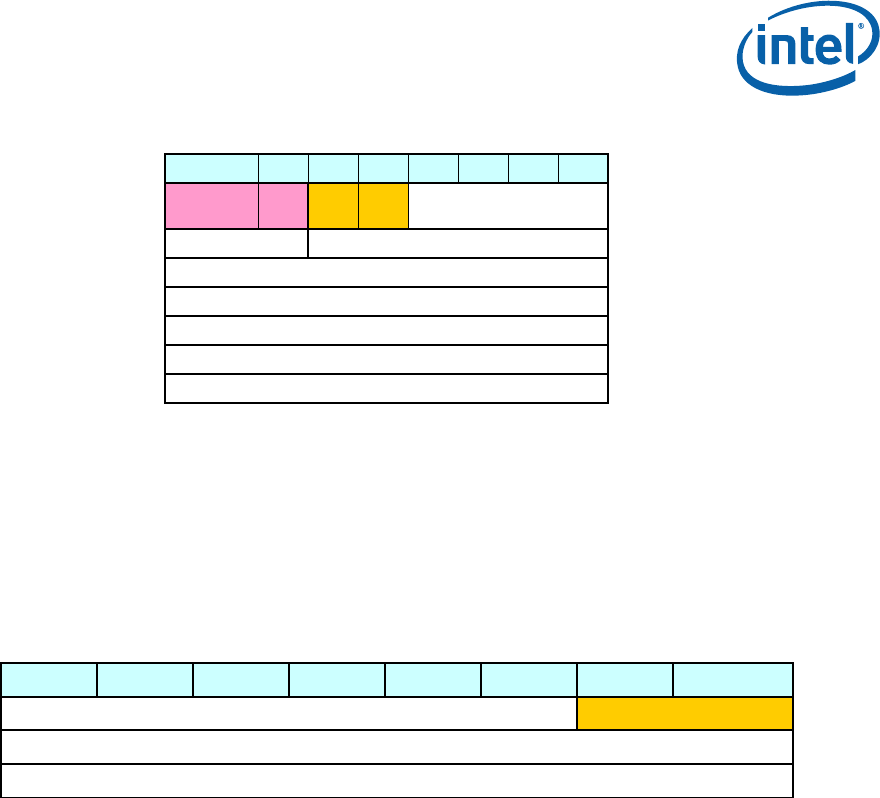
Real Time Instruction Trace
December 2015
Real Time Instruction Trace
Programming Reference v1.05
53
7 6 5 4 3 2 1 0
1 1 0 1
Actual Core/Bus
Ratio[5:2]
ACBR[1:0] Effective Core/Bus Ratio[5:0]
Big Time Counter 0 (HW TSC[7:0])
Big Time Counter 1 (HW TSC[15:8])
Big Time Counter 2 (HW TSC[23:16])
Big Time Counter 3 (HW TSC[31:24])
Big Time Counter 4 (HW TSC[39:32])
Figure 12: Super Time Synch packet
4.2.14 Cycle Count Packet
For certain RTIT trace packets additional cycle count will be appended after the normal packet in cycle
accurate mode. The following is the cycle count packet format:
7 6 5 4 3 2 1 0
Cycle Count 0 CCNT
Cycle Count 1
Cycle Count 2
Figure 13: Cycle Count Packet
CCNT is used to indicate the cycle count length:
2’b01: 1B Cycle Count Packet. Cycle Count 0 carries the value in RTIT_CNTP[5:0]. This is for
the case when RTIT_CNTP[21:6] == 0;
2’b10: 2B Cycle Count Packet. Cycle Count 0 carries the value in RTIT_CNTP[5:0]; Cycle
Count 1 carries the value in RTIT_CNTP[13:6]. This is for the case when RTIT_CNTP[21:14]
== 0;
2’b11: 3B Cycle Count Packet. Cycle Count 0 carries the value in RTIT_CNTP[5:0]; Cycle
Count 1 carries the value in RTIT_CNTP[13:6]; Cycle Count 2 carries the value in
RTIT_CNTP[21:14].
2’b00: reserved
The RTIT cycle counter may stop in sleep states. An STS packet should be sent out on wakeup from
any sleep states where the cycle counter does not count.

Real Time Instruction Trace
Real Time Instruction Trace
Programming Reference v1.05
December 2015
54
4.2.15 Cycle Accurate Mode
Cycle accurate mode is enabled when RTIT_CTL.Cycle_Acc is set.
The following RTIT packets will always be followed by a cycle count packet when the cycle accurate
mode is enabled:
Full TNT Packet (a TNT packet with info on 6 branches)
Target IP Packet
Flow Update Packet
Paging Information Packet
Mini Time Count
Super Time Sync
The appended cycle count sends out the value stored in RTIT_CNTP. The count increments every CPU
core clock, and value is an accurate indication of the program flow (specifically the time between
retiring the instructions that generated the packets).
The cycle count in RTIT_CNTP only tells the time since the last cycle count packet. So every time a
Cycle Count packet is sent, RTIT_CNTP[CNTP] is reset to zero.
The cycle count packet is not appended to partial TNT packets, TraceSTOP, or Packet Stream Buffer. It
is not appended to the Partial TNT packet (a TNT packet of less than 6 branches) because it is not
needed. The partial TNT packet is always immediately followed by another packet (which will have
forced out the partial TNT). The partial TNT packet will have a cycle count packet.
Conditional jumps update the TNT buffer, but do not generate a TNT packet or a cycle count packet.
Thus the exact time those jumps retired is not indicated in the RTIT output.
4.3 Synchronous packets
There are three types of packets generated on flow control instructions (e.g., branches), and one
packet generated on paging changes. The packet layout and complete descriptions can be found in
the packet section of this document; however, the following table provides a brief description of the
three synchronous packets (TNT, Target IP, and Flow Update) packets as well as the paging change
packet (Paging Info Packet)
“TNT” packet: Holds taken/not taken info about direct, conditional jumps (e.g. JNZ)
• Target IP Packet: Holds destination address of indirect jump/transfers (e.g., JMP
indirect or #PF exception)
• Flow Update packet: Explains where we came from (e.g., address pushed onto stack for
#PF exception)
• Paging Info packet: Generated on CR3 changes or paging enable/disable. Explains
which app we switched to and whether paging is enabled.
Direct unconditional branches such as JMP near relative do not generate packets.

Real Time Instruction Trace
December 2015
Real Time Instruction Trace
Programming Reference v1.05
55
4.3.1 Packets sent out in various situations
The following table describes what packets are generated with each type of operation.
Table 19: Packet Generation under Different Enable Conditions
# Operation PacketEn set
before we
fetched this
instruction?
PacketEn set
after this
instruction
completes?
Branches
in the TNT
buffer?
Packets
generated
1 Normal non-jump
operation (EOM)
Yes yes x Nothing
2 Normal non-jump
operation (EOM)
No no x Nothing
3 Normal non-jump
operation (EOM)
Yes no no FUP.PGD with NLIP
4 Normal non-jump
operation (EOM)
Yes no yes TNT, FUP.PGD with
NLIP
5 Normal non-jump
operation (EOM)
No yes no (yes is
not possible
here, even
if there is a
buffer
overflow)
FUP.PGE with NLIP
6 Unconditional
direct jump (like
JMP near)
Yes yes x Nothing
7 Unconditional
direct jump (like
JMP near)
No no x Nothing
8 Unconditional
direct jump (like
JMP near)
Yes no no FUP.PGD with
NLIP
9 Unconditional
direct jump (like
JMP near)
Yes no yes TNT, FUP.PGD with
NLIP
10 Unconditional
direct jump (like
JMP near)
No yes no (yes is
impossible)
FUP.PGE with BLIP
11 Conditional taken
jump that does
not fill up the
internal TNT
buffer (not the 6th
conditional jump)
Any any x Same as direct
jump

Real Time Instruction Trace
Real Time Instruction Trace
Programming Reference v1.05
December 2015
56
# Operation PacketEn set
before we
fetched this
instruction?
PacketEn set
after this
instruction
completes?
Branches
in the TNT
buffer?
Packets
generated
12 Conditional not
taken jump that
does not fill up
the internal TNT
buffer (not the 6th
conditional jump)
Any any x Same as "normal
non-jump
operation"
13 Conditional taken
jump up that fills
up the internal
TNT buffer
Yes yes yes (no is
not
possible)
TNT
14 Conditional taken
jump up that fills
up the internal
TNT buffer
No no yes (no is
not
possible)
impossible,
because wouldn't
update TNT buffer
15 Conditional taken
jump up that fills
up the internal
TNT buffer
Yes no yes (no is
not
possible)
TNT, FUP.PGD with
NLIP
16 Conditional taken
jump up that fills
up the internal
TNT buffer
No yes yes (no is
not
possible)
impossible,
because wouldn't
update TNT buffer
17 Conditional not
taken jump up
that fills up the
internal TNT
buffer
Yes yes yes (no is
not
possible)
TNT
18 Conditional not
taken jump up
that fills up the
internal TNT
buffer
No no yes (no is
not
possible)
impossible,
because wouldn't
update TNT buffer
19 Conditional not
taken jump up
that fills up the
internal TNT
buffer
Yes no yes (no is
not
possible)
TNT, FUP.PGD with
NLIP
20 Conditional not
taken jump up
that fills up the
internal TNT
buffer
No yes yes (no is
not
possible)
impossible,
because wouldn't
update TNT buffer
21 Near indirect jump
(like RET or CALL
indirect mem)
Yes yes no TIP with BLIP

Real Time Instruction Trace
December 2015
Real Time Instruction Trace
Programming Reference v1.05
57
# Operation PacketEn set
before we
fetched this
instruction?
PacketEn set
after this
instruction
completes?
Branches
in the TNT
buffer?
Packets
generated
22 Near indirect jump
(like RET or CALL
indirect mem)
Yes yes yes TNT, TIP with BLIP
23 Near indirect jump
(like RET or CALL
indirect mem)
No no x Nothing
24 Near indirect jump
(like RET or CALL
indirect mem)
Yes no no TIP with BLIP and
FUP.PGD with NLIP
25 Near indirect jump
(like RET or CALL
indirect mem)
Yes no yes TNT, TIP with BLIP
and FUP.PGD with
NLIP
26 Near indirect jump
(like RET or CALL
indirect mem)
No yes no (yes is
impossible)
Just FUP.PGE with
BLIP
27 Far Transfer (Far
Jump/Call/Ret/Int
errupt/Exception/
etc.)
Yes yes no FUP.Far with NLIP
(see footnote) and
TIP with BLIP
28 Far Transfer (Far
Jump/Call/Ret/Int
errupt/Exception/
etc.)
Yes yes yes TNT, FUP.Far with
NLIP (see footnote
2) and TIP with
BLIP
29 Far Transfer (Far
Jump/Call/Ret/Int
errupt/Exception/
etc.)
No no x Nothing
30 Far Transfer (Far
Jump/Call/Ret/Int
errupt/Exception/
etc.)
Yes no (but
ContextEn is 1)
no FUP.PGD with
NLIP (see
footnotes 2 and 6)
and TIP with BLIP
31 Far Transfer (Far
Jump/Call/Ret/Int
errupt/Exception/
etc.)
Yes no (but
ContextEn is 1)
yes TNT, FUP.PGD with
NLIP (see
footnotes 2 and 6)
and TIP with BLIP
32 Far Transfer (Far
Jump/Call/Ret/Int
errupt/Exception/
etc.)
Yes no (ContextEn is
now 0)
no FUP.PGD with NLIP
(see footnote 2)
33 Far Transfer (Far
Jump/Call/Ret/Int
errupt/Exception/
etc.)
Yes no (ContextEn is
now 0)
yes TNT, FUP.PGD with
NLIP (see footnote
2)

Real Time Instruction Trace
Real Time Instruction Trace
Programming Reference v1.05
December 2015
58
# Operation PacketEn set
before we
fetched this
instruction?
PacketEn set
after this
instruction
completes?
Branches
in the TNT
buffer?
Packets
generated
34 Far Transfer (Far
Jump/Call/Ret/Int
errupt/Exception/
etc.)
no (ContextEn was
0)
Yes no (yes is
impossible)
Just FUP.PGE with
BLIP
35 Far Transfer (Far
Jump/Call/Ret/Int
errupt/Exception/
etc.)
no (ContextEn was
1)
Yes no (yes is
impossible)
Just FUP.PGE with
BLIP
36 SMI or VM-exit Yes No no FUP.PGD with
address saved into
VMCS/SMRAM as
IP
37 SMI or VM-exit Yes No yes TNT, FUP.PGD with
address saved into
VMCS/SMRAM as
IP
38 RSM or VM-entry No Yes no (yes is
impossible)
FUP.PGE with BLIP
39 MOV to CR3 Yes Yes no CR3 packet when
enabled, STS when
enabled
40 MOV to CR3 Yes Yes yes TNT, CR3 packet
when enabled, STS
when enabled
41 MOV to CR3 No No no (yes is
impossible)
CR3 packet when
enabled in the
current mode, STS
when enabled
42 MOV to CR3 No Yes no (yes is
impossible)
CR3 packet when
enabled in the
current mode, STS
when enabled,
FUP.PGE with NLIP
43 MOV to CR3 Yes no no CR3 packet when
enabled in the
current mode, STS
when enabled,
FUP.PGD with NLIP
44 MOV to CR3 Yes no yes TNT, CR3 packet
when enabled in
the current mode,
STS when enabled,
FUP.PGD with NLIP
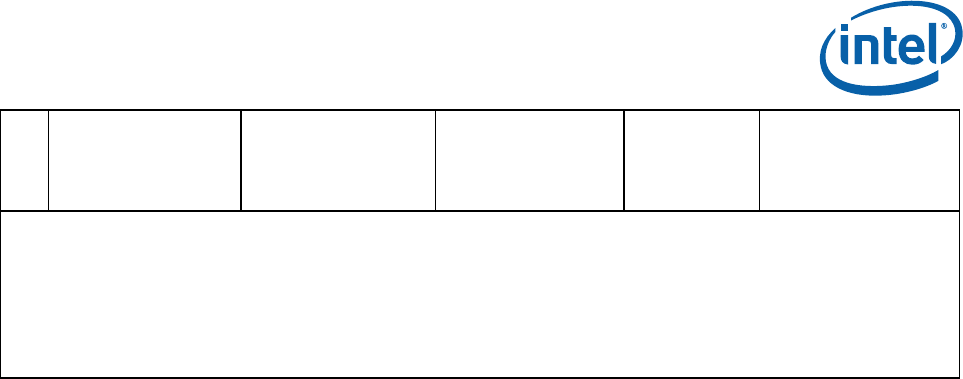
Real Time Instruction Trace
December 2015
Real Time Instruction Trace
Programming Reference v1.05
59
# Operation PacketEn set
before we
fetched this
instruction?
PacketEn set
after this
instruction
completes?
Branches
in the TNT
buffer?
Packets
generated
Footnote 1: The order of the packets will be that specified in the list.
Footnote 2: The "NLIP" of a far transfer which changes privilege levels is actually the address it
would have saved into the FROM field of the LBRs for Intel
®
Atom™ processors (or on the stack).This
is actually the CLIP for exceptions.
Footnote 3: This does not list cycle count packets. For now, assume that each TNT, FUP and TIP has
a cycle count packet after it. Any second or third cycle counts sent out on an instruction should be 0
(since sending out the first cycle count zeroed it.
4.3.2 Understanding Entering/Exiting Packet Enabled
Region
Whether an instruction generates a synchronous packet is determined by the value of packet enable at
the start of the instruction.
A conditional (taken or not taken) jump that starts with PacketEn cleared and ends with PacketEn set
does not update the TNT buffer. A conditional jump that starts with
PacketEn set and ends with
PacketEn cleared does update the TNT buffer; but it will also immediately follow it by generating a
FUP.PGD packet that will evict whatever is in the TNT buffer.
A RET that starts with PacketEn cleared and ends with PacketEn set does not send out a TIP or update
the TNT buffer. A RET that starts with
PacketEn set and ends with PacketEn cleared does sent out the
TIP or updates the TNT buffer (depending on whether it matches LAST_CALL_NLIP)
An indirect jump that starts with PacketEn cleared and ends with PacketEn set does not send out a TIP
packet. An indirect jump that starts with
PacketEn set and ends with PacketEn cleared does send out a
TIP packet.
A far transfer that starts with PacketEn cleared and ends with PacketEn set does not send out a
FUP.FAR or a TIP packet. A far transfer that starts with
PacketEn set and ends with PacketEn cleared
does send out a TIP packet (although the FUP.FAR is likely combined with the needed FUP.PGD
packet).
A CALL that starts with PacketEn cleared and ends with PacketEn set does not update
LAST_CALL_NLIP. A CALL that starts with
PacketEn set and ends with PacketEn cleared does update
LAST_CALL_NLIP.
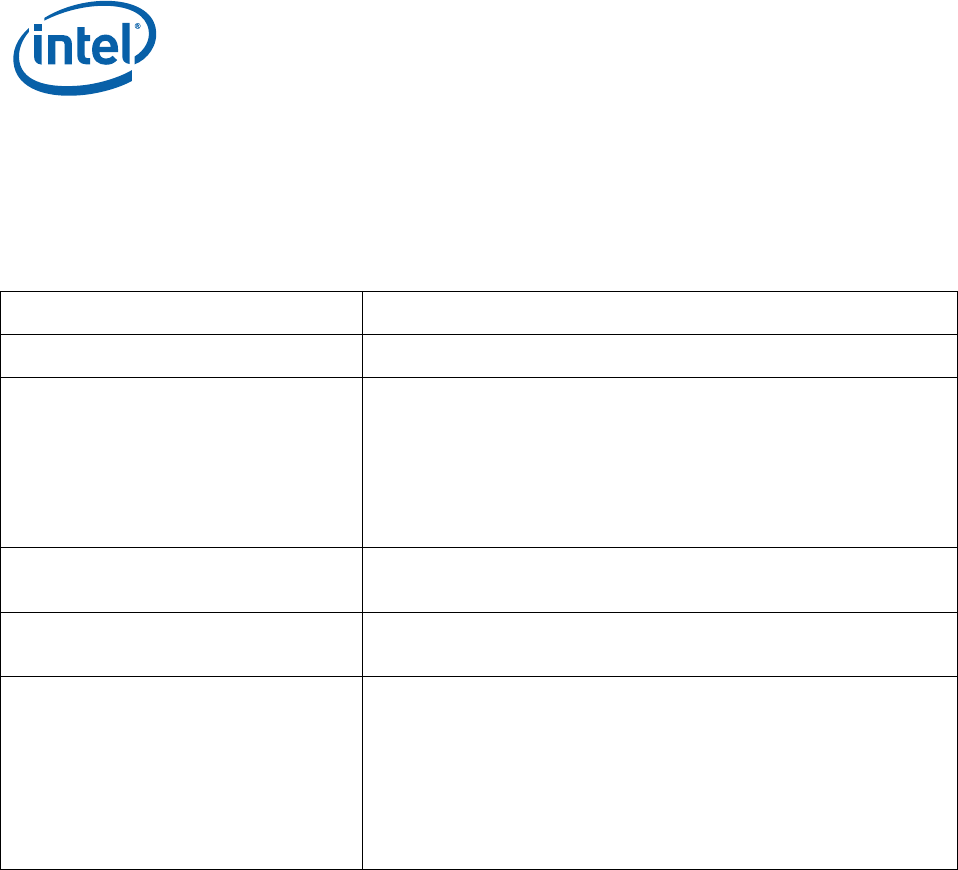
Real Time Instruction Trace
Real Time Instruction Trace
Programming Reference v1.05
December 2015
60
4.4 Asynchronous Packet Generation
There are six packet types that are not directly linked to instructions, exceptions, traps, or interrupts.
The packet layout and complete descriptions can be found in the packet section of this document;
however, the following table provides a brief description of the six asynchronous packet types.
Table 20: Asynchronous Packets Descriptions
Packet Description
Packet Stream Buffer (PSB) Packet Indicates start of trace, or a synchronization point
Flow Update Packet (FUP) Sent out when cycle counter overflows
Sent when turning on packet generation (e.g. where did we
enter monitored routine)
Sent when turning off packet generation (e.g. where did we
leave monitored routine)
Trace Stop packet Sent when we trigger TraceStop. This turns off RTIT and ends
packet generation
Mini Time Counter Packet A small wall-clock time counter that can be used to
synchronize time between cores
Super Time Synch packet Sends out the big time counter (40 bits of HW TSC) and
core/bus ratio when frequency may have changed
Can be used to synchronize time between cores and tells the
frequency
Finally shows when the CPU is waking up out of sleep
state/STPCLK. (the packet doesn’t specify which sleep state)

Real Time Instruction Trace
December 2015
Real Time Instruction Trace
Programming Reference v1.05
61
Appendix A: Programming Examples
The following section provides examples for a few of the many available RTIT configurations.
To ensure consistent tracing, configure RTIT prior to enabling it.
Scenario: The user desires to trace a single, specific user application.
Configuration:
Set RTIT Control to trace only USER level code.
Set the Trace LIP addresses to cover the desired application address of interest.
Set the CR3 match address to the CR3 of the user application.
Start tracing: Set
Trace_En to enable tracing.
Scenario: The user desires to trace all applications both user and OS, and activate tracing.
Configuration:
Set RTIT Control to trace both OS and USER level code.
Start tracing: Set
Trace_En to enable tracing.
Scenario: The user desires to trace OS driver code only.
Configuration:
Set RTIT Control to trace OS level code and activate tracing.
Set the Filter En address to the desired driver’s address of interest.
Start tracing: Set
Trace_En to enable tracing.

Real Time Instruction Trace
Real Time Instruction Trace
Programming Reference v1.05
December 2015
62
Appendix B: Operation Consideration
4.1 Sleep states
4.1.1 C1/Halt/Shutdown sleep state
During the C1, halt and shutdown sleep states:
The cycle counter will stop counting.
MiniTime counter packets will not be issued.
The RTIT buffer will stop draining to memory.
An STS packet will be sent on waking up from C1, halt, and shutdown sleep states.
4.1.2 C2 sleep state
During the C2 sleep state:
The cycle counter will stop counting.
MiniTime counter packets will not be issued.
The RTIT buffer will stop draining to memory.
An STS packet will be sent on waking up from C2 sleep state.
4.1.3 C4 sleep state
During the C4 sleep state:
The cycle counter will stop counting.
MiniTime counter packets will not be sent.
The RTIT buffer will be fully drained before entering C4 state.
All of the above will happen for a brief time even if there is a C4 abort and sleep state is not
truly entered.
An STS packet will be sent on waking up from C4 sleep state.
4.1.4 C6 and S0i1/S0i2/S0i3 sleep state
During the C6 (or S0i1 or S0i2 or S0i3) sleep state:
The cycle counter will stop counting.
MiniTime counter packets will not be sent.
The RTIT buffer will be fully drained before entering the sleep state.
All of the above will happen for a brief time even if there is an abort and the sleep state is not
truly entered.
An STS packet will be sent on waking up from C6 or S0i1 or S0i2 or S0i3 sleep states.
4.2 Re-Enabling RTIT
The sequence of steps required to enable RTIT after the initial configuration or to re-
enable RTIT after a TraceStop packet is received will depend on the intended tracing
configuration.

Real Time Instruction Trace
December 2015
Real Time Instruction Trace
Programming Reference v1.05
63
4.2.1 Re-Enabling with Same Configuration
1. ClearFilterEnandBuffOvfthroughRTIT_STATUS_MSR(seeSection3.3.2)
2. ResetRTIT_TNT_BU F FMSRusingit’sresetvalue(seeSection3.3.13)
3. OptionallyResetthefollow ingMSRsusingtheircorrespondingresetvalues
a. RTIT_CNTPMSR(seeSection3.3.4)
b. RTIT_LAST_LIPMSR(seeSection3.3.7)
c. RTIT_LAST_CALL_NLIPMSR(seeSection3.3.14)
4.2.2 Re-Enabling with Different Output Region
In addition to the steps in section 4.2.1, if the output region will be changed or if the
STM/PTI block was reinitialized (e.g. by an earlier TraceStop closing the file handle)
then the RTIT_OFFSET MSR will need to be initialized (see Section 3.3.12).
If the output region is a new memory location, then RTIT_BASEADDR MSR and
RTIT_LIMIT_MASK MSR will need to be updated (see Sections 3.3.10 and 3.3.11
respectively).
4.2.3 Re-Enabling with Different Traced Region
In addition to the steps in section 4.2.1, if the trace coverage will be changed then the
RTIT_EVENTS MSR and the RTIT_LIP0-3 MSRs will need to be initialized appropriately
(see Sections 3.3.5 and 0 respectively).
It may also be necessary to update the RTIT_CTL MSR and the RTIT_CR3_MATCH MSR
(see Sections 3.3.2 and 3.3.8 respectively) depending on the new trace coverage
requirements.

Real Time Instruction Trace
Real Time Instruction Trace
Programming Reference v1.05
December 2015
64
Appendix C: Background and Related
Processor Mechanisms
4.3 Existing debug and performance monitoring
The following are a list of available debug and monitoring features in Intel
®
Atom™ processors.
Break point
LBR/LER
Performance monitoring/PEBS
DS for BTS/PEBS
Those features are compared with real time trace in the following sections.
4.4 Break point
There are 4 sets of debug break point registers, which are stored in 64b MSR DR0 through DR3.
Depending on configuration bits R/W0 though R/W1 in MSR DR7, the following are the possible
actions:
00 — Break on instruction execution only.
01 — Break on data writes only.
10 — Break on I/O reads or writes.
11 — Break on data reads or writes but not instruction fetches.
After the break point trigger, a fault is raised for instruction break point, and a trap is raised for data
and I/O access.
4.5 LBR/LER
After branch instruction retired, or after exception, the FROM and TO information of the LIP is
collected in a buffer. This buffer can be drained out of system bus or into the memory with processor
support.
Real time trace leverages extensively the LBR/LER buffer with regard to the indirect jump. The target
destination LIP will be carried out in branch address packet. But real time trace does not just output
the raw LIP, as stored in LBR. The MSBs that do not change from previous LIP packet will be
suppressed, and MSBs of zero will also be suppressed.
For direct jump where TO Lip is readily available from the assembly code, a simple TAKEN or NOT
TAKEN bit is sent by real time trace to indicate the program flow, and up to 6 T/NT bits can be packed
in a single byte of trace packet.
Except for the branch prediction, real time trace covers all the information in LBR/LER, with efficiency
greatly improved by compression.
The draining of the buffer is discussed in BTS/DS section.

Real Time Instruction Trace
December 2015
Real Time Instruction Trace
Programming Reference v1.05
65
4.6 Performance monitoring/PEBS
There are architecturally defined performance counters to monitor events such as:
Unhalted Core Cycles
Instruction Retired
Unhalted Reference Cycles
LLC Reference
LLC Misses
Branch Instruction Retired
Branch Misses Retired
And PEBS counts more precise events such as how many load retired that missed L1.
Real time trace is different in the following:
Real time trace counts events at instruction level. i.e., how many times the instruction in
certain LIP is executed. This event can be used as enabling events for counter. As counters in
real time trace are fully programmable, it is easily concatenated for larger capacity.
Real time trace provide cycle accurate mode, so that the exact flow and timing of the program
is available.
4.7 DS for BTS/PEBS
DS is the way to write LBR and performance counters into memory. IA32_DS_AREA MSR holds the LIP
to DS buffer management area.
DS save area is within kernel space, and can be larger than a page and can straddle page
boundaries.
DS buffer management area contains buffer base to BTS/PEBS, along with index, max IP,
threshold and other information
Based on the buffer base and index, BTS/PEBS can be written into appropriate part of the
memory.
The BTS/PEBS write can be configured so that if the threshold is cross, an exception is raised.
Based on the way how DS storage is managed, the processor first has to fetch the buffer management
information from DS save area and then store the buffer. This is a cycle-consuming process.
4.8 CR3 States
CR3 is the control register by which the memory paging is managed. This register can be loaded with
MOV instruction.
X86 supports 3 paging modes:
32-bit
PAE
IA-32e
For 32-bit mode, the following fields of CR3 are used:
Bit 3: PWT

Real Time Instruction Trace
Real Time Instruction Trace
Programming Reference v1.05
December 2015
66
Bit 4: PCD
Bit [31:12]: Page directory address
For PAE mode, the following fields of CR3 are used:
Bit [31:5]: Address of page-directory-pointer table
For IA-32E mode, the following fields of CR3 are used:
Bit 3: PWT
Bit 4: PCD
Bit [`MAXPHYADDR-1:12]: physical address to PML4 table
4.9 Virtual Machine Extension
VMX refers to Virtual Machine EXtension, which supports processor virtualization for multiple software
environments.
The following instructions to enter VM mode will affect the programming flow:
VMCALL
VMRESUME
VMLAUNCH
VMEXIT – (VMX exits can be caused by either an exception or event)

Real Time Instruction Trace
December 2015
Real Time Instruction Trace
Programming Reference v1.05
67
Appendix D: Glossary and Reference
4.10 Glossary
The document uses the terms listed in the following table.
Table 21: Glossary
Term Definition
Last Branch
Record (LBR)
Debug feature that stores last branch information in a hardware stack,
see SDM
Branch Trace
Store (BTS)
Debug mode that stores branch information to memory, see SDM
Model-Specific
Registers (MSR)
Control registers used to enable and disable certain features of the
processor implementation.
Tangier (TNG) LPIA SOC based on Silvermont core
MIPI Mobile Industry Processor Interface
PTI MIPI Parallel Trace Interface
LIP Linear Instruction Pointer
NLIP Next LIP. This is the same as current LIP + instruction length
BLIP Branch LIP. This is the target of the branch, or event handler address for
exceptions/interrupts
CPL Current Privilege Level, see SDM
CR3 Control Registers to the head of the page tables. See SDM
Trigger_Start Event that causes entrance to the TriggerEnable mode.
Trigger_Stop Event that causes an exit from the TriggerEnable mode, and generally
disables RTIT functionality.
Filter_Event Event that enables the Packet Enable region, which starts packet
generation
ContextEn In the correct mode to be tracing. E.g. right CPL, CR3 value, SMM, VMM,
etc.
TriggerEn RTIT is enabled (not de-featured) and we have seen the start trigger
condition, but not the stop trigger condition
PacketEn The context and trigger enables are set and the filter tells us that we
should be sending out packets.
Most packets are only sent out when PacketEn is set.
Packet Stream
Boundary (PSB)
RTIT output packet that is used to help a trace reader find packet start
edge
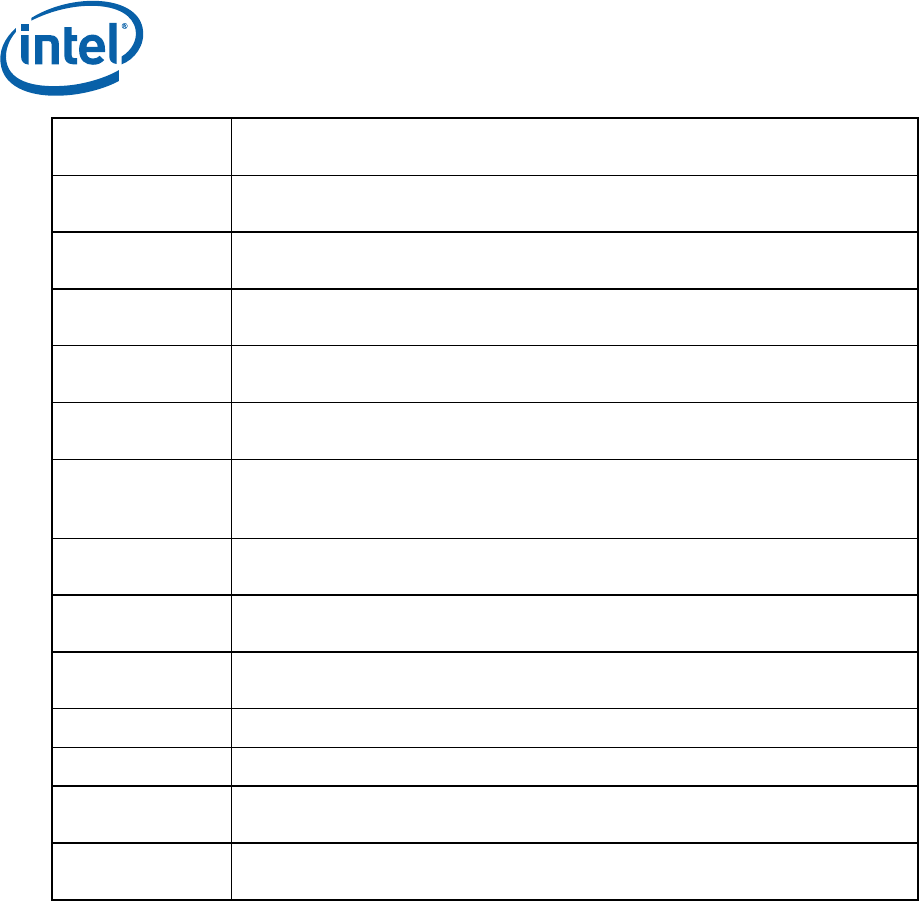
Real Time Instruction Trace
Real Time Instruction Trace
Programming Reference v1.05
December 2015
68
TNT Packet RTIT packet that contains taken/not-taken info for direct, conditional
branches
Flow Update
Packet
RTIT packet that contains the “from” address for far transfers, as well as
when entering/leaving packet enable mode
Target IP Packet RTIT packet that contains the target of a branch, sent out on indirect
branches
Change of Flow
(COFI)
X86 instruction or event that causes a program flow change, e.g.
Branches, exceptions, interrupts.
Direct Transfer
COFI
X86 branch whose target is embedded in the instruction bytes. These
are not traced by RTIT, as only conditional branches are traced.
Indirect Transfer
COFI
X86 branches whose targets are in a register or memory location, which
requires the trace to contain the branch target to track program flow.
Far Transfer
COFI
Far jumps, interrupts, exceptions that use signal_event_jump Uop. Both
the “from” and “to” address are required to track program flow for
interrupts/exceptions.
Big Time
Counter (BTC)
[31:0] of BNL_CR_TSC creg (this is not the exact same as the
IA32_CR_TSC MSR that software observes)
Mini Time
Counter (MTC)
[13:6] of BNL_CR_TSC creg (this is not the exact same as the
IA32_CR_TSC MSR that software observes)
Super TC packet Packet with BTC and frequency info sent on Silvermont frequency
changes
Mini TC packet Packet with MTC sent based on an MTC mask MSR
Event resource Hardware resources used to generate events, ex. Address comparators.
Event definition Boolean combinations of Event Resources used to generate events, ex.
Trigger_Start
Cycle Accurate
Mode
Mode in which the cycle count is appended to RTIT packets. Used for
performance analysis.
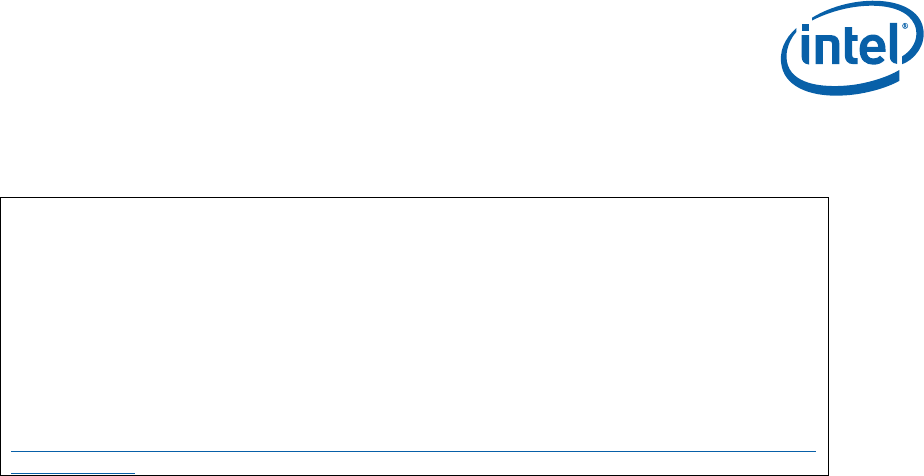
Real Time Instruction Trace
December 2015
Real Time Instruction Trace
Programming Reference v1.05
69
4.11 Reference Documents
Table 22: References
Intel
®
64 and IA-32 Architectures Software Developer’s Manual Volume 1: Basic
Architecture
Intel
®
64 and IA-32 Architectures Software Developer’s Manual Volume 2A/2B:
Instruction Set Reference
Intel
®
64 and IA-32 Architectures Software Developer’s Manual, Volume 3A/3B: System
Programming Guide
All Software Developer Manuals (SDM) are available at:
http://www.intel.com/content/www/us/en/processors/architectures-software-developer-
manuals.html

Real Time Instruction Trace
Real Time Instruction Trace
Programming Reference v1.05
December 2015
70
Appendix E: Errata
E1 RTIT Trace May Contain FUP.FAR Packet With Incorrect Address
Problem:
The FUP.FAR (Flow Update Packet for Far Transfer) generated by RTIT (Real
Time Instruction Trace) on a far transfer instruction should contain the linear
address of the first byte of the next sequential instruction after the far transfer
instruction. Due to this erratum, far transfer instructions with more than 3
prefixes may incorrectly include an address between the first byte of the far
transfer instruction and the last byte of the far transfer instruction.
Implication:
The RTIT Trace decoder may incorrectly decode the trace due to an incorrect
address in the FUP packet.
Workaround: The RTIT trace decoder can identify a FUP.FAR in the middle of a far transfer
instruction and treat that FUP.FAR as if it was coming from the first byte of the
following sequential instruction.
Status: No fix
E2 Extra RTIT FUP.PGD Packets Can Result From Use Of IP Filtering Or
TraceStop
Problem:
When this erratum occurs, the RTIT (Real Time Instruction Trace) output will
contain extra FUP.PGD (Flow Update Packet, Packet Generation Disabled)
packets. An instruction execution or event under the following conditions may
produce an extra FUP.PGD packet:
1. PacketEn (an internal enable signal computed by ANDing the TriggerEn [bit
2], ContextEn [bit 1], and FilterEn [bit 0] fields in the RTIT_STATUS MSR
[769H]) is 0 both before and after the instruction or event,
2. And either
a. The instruction or event causes RTIT_STATUS.FilterEn to change from
1 to 0, or
b. The instruction or event causes RTIT_CTL.TraceActive (MSR 768H) to
be cleared by a TraceStop condition.
3. And either
a. The instruction or event causes RTIT_STATUS.ContextEn to change
from 0 to 1, or
b. The instruction is a WRMSR that sets both RTIT_CTL.Trace_En and
the RTIT_CTL.TraceActive to 1, with one or both of those bits having
been 0 before the WRMSR instruction.
Implication:
The RTIT Trace decoder may incorrectly decode the trace due to an
unexpected FUP.PGD packet.

Real Time Instruction Trace
December 2015
Real Time Instruction Trace
Programming Reference v1.05
71
Workaround: The RTIT trace decoder can identify and ignore extra FUP.PGD packets by
ignoring any FUP.PGD that follows another FUP.PGD, without an intervening
FUP.PGE (Flow Update Packet, Packet Generation Enabled).
Status: No fix
E3 RTIT May Delay The PSB By One Packet
Problem:
After an RTIT (Real Time Instruction Trace) packet that exceeds the limit
specified by Pkt_Mask in RTIT_PKT_CNT (MSR 77Ch) bits [17:16], the PSB
(Packet Stream Boundary) packet should be sent immediately. Due to this
erratum, the PSB packet may be delayed by one packet.
Implication:
The PSB packet may be delayed by one packet.
Workaround: None identified.
Status: No fix
E4 RTIT TraceStop Condition Detected During Buffer Overflow May Not Clear
TraceActive
Problem:
If an RTIT (Real Time Instruction Trace) TraceStop condition is detected while
RTIT_STATUS.Buffer_Overflow MSR (769H) bit 3 is set, the processor may not
clear RTIT_CTL.TraceActive MSR (768H) bit 13, and tracing will continue after
the overflow resolves. Such a case will be evident if the TraceStop packet is
inserted before overflow is resolved, as indicated by the FUP.BuffOvf (Flow
Update Packet for Buffer Overflow) packet.
Implication:
The RTIT trace will continue tracing beyond the intended stop point.
Workaround: None identified.
Status: No fix
E5 RTIT FUP.BuffOvf Packet May Be Incorrectly Followed By A TIP Packet
Problem:
When RTIT (Real Time Instruction Trace) suffers an internal buffer overflow,
packet generation stops temporarily, after which a FUP.BuffOvf (Flow Update
Packet for Buffer Overflow) is sent to indicate the LIP that follows the
instruction upon which tracing resumes. In some cases, however, this packet
will be immediately followed by a FUP.TIP (Flow Update Packet for Target IP)
which was generated by a branch instruction that executed during the
overflow. The IP payload of this FUP.TIP will be the LIP of the instruction upon
which tracing resumes.

Real Time Instruction Trace
Real Time Instruction Trace
Programming Reference v1.05
December 2015
72
Implication: The spurious FUP.TIP packet may cause the RTIT trace decoder to fail.
Workaround: The RTIT trace decoder should ignore any FUP.TIP packet that immediately
follows a FUP.BuffOvf whose IP matches the IP payload of the FUP.BuffOvf.
Status: No fix
E6 RTIT CYC Packet Payload Values May Be Off By 1 Cycle
Problem:
When RTIT (Real Time Instruction Trace) is enabled with RTIT_CTL.Cyc_Acc
MSR (768H) bit 1 set to 1, all CYC (Cycle Count) packets have a payload value
that is one less than the number of cycles that have actually passed. Note that
for CYC packets with a payload value of 0, the correct value may be 0 or 1.
Implication:
The trace decoder will produce inaccurate performance data when using CYC
packets to track software performance.
Workaround: As a partial workaround, the trace decoder should add 1 to the payload
value of any CYC packet with a non-zero payload.
Status: No fix
E7 First MTC Packet After RTIT Enable May Be Incorrect
Problem:
When RTIT (Real Time Instruction Trace) is enabled, indicated by TriggerEn in
bit 2 of the RTIT_STATUS MSR (769H) transitioning from 0 to 1, the first MTC
(Mini Time Counter) packet may be sent at the wrong time.
Implication:
The RTIT trace decoder will make incorrect assumptions about the TSC value
based on an asynchronous MTC packet.
Workaround: The RTIT trace decoder should ignore the first MTC that follows trace
enabling.
Status: No fix
E8 Some RTIT Packets Following PSB May be Sent Out of Order or Dropped
Problem:
When a complex micro-architectural condition occurs concurrently with the
generation of a RTIT (Real-Time Instruction Trace) PSB (Packet Stream
Boundary) packet, the packets that immediately follow the PSB could precede
or overwrite some older packets. This erratum applies to no more than 21
packets immediately following the PSB.
Implication:
The RTIT packet output immediately following a PSB may not accurately reflect
software behavior, and may result in an RTIT decoder error.

Real Time Instruction Trace
December 2015
Real Time Instruction Trace
Programming Reference v1.05
73
Workaround: None identified.
Status: No fix
